1lumen selects and reviews products personally. We may earn affiliate commissions through our links, which help support our testing.
Fenix LD12R review
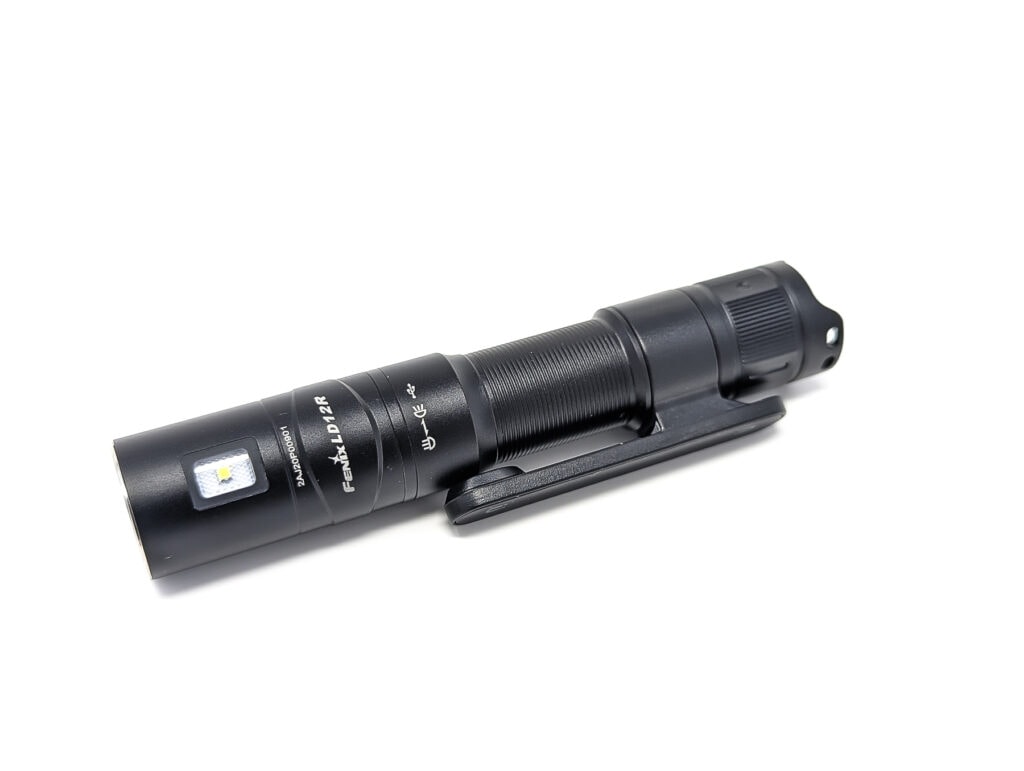
Fenix LD12R specs
| Brand & Model | Fenix LD12R |
|---|---|
| Flashlight category | EDC flashlight |
| LED | Luminus SST20 and SC1818C |
| Max. output | 600 lumens |
| Max. beam distance | 186 meters |
| Max. beam intensity | 8616 cd |
| Battery config. | 1x 14500 or AA |
| Onboard charging | Yes, USB-C |
| Main modes | 7 |
| Blinkies | N/A |
| Waterproof | IP68 |
| Review publication date | October 2023 |
Review intro:
Fenix makes a huge array of lights. In fact, they have an actual PDF catalog on their website (I imagine it’s probably also distributed in paper form as well) that is 48 pages long and chock-full of products ranging from tiny EDC flashlights all the way up to a couple of really big boys that I’ve been fortunate enough to check out: the LR50R 12,000 lumen monstrosity and the HT30R 1500m throw LEP. If you need a light, chances are that Fenix will have a nice offering to fill that need.
By and large, I really like Fenix – my first “real” flashlight was a Fenix (the 187-lumen E25 model, if you’re curious). From my experience, Fenix lights are really well designed, they use quality materials and finishes, have great constant-current drivers, and publish truthful ANSI specs. I’ve had the opportunity to review several Fenix flashlights over the past few years – all were very nice lights. Today I’m reviewing the new LD12R, an entry in Fenix’s LD series which are lightweight flashlights “created for the outdoor professional.”
It features dual output sources, flexible power options, built-in charging, and a handy magnetic body clip.
Getting started with the Fenix LD12R is pretty straightforward: remove the flashlight from the box, unscrew the battery tube, and remove the little insulator disc. Put the battery & tube back on and you’re good to go!
Package quality.
The packaging for the Fenix HT32 is instantly recognizable as having come off the same line as the other Fenix models that I recently reviewed. They used the exact same design language and materials: a showy black and orange carton with a heavy-duty plastic tray inside. I think it’s great that Fenix is using consistent packaging as it helps drive brand recognition. Arranged in the tray were:
- Fenix LD12R
- Battery (ARB-L14-800)
- Charging cable
- Spare o-ring
- Lanyard
- Manual and other literature
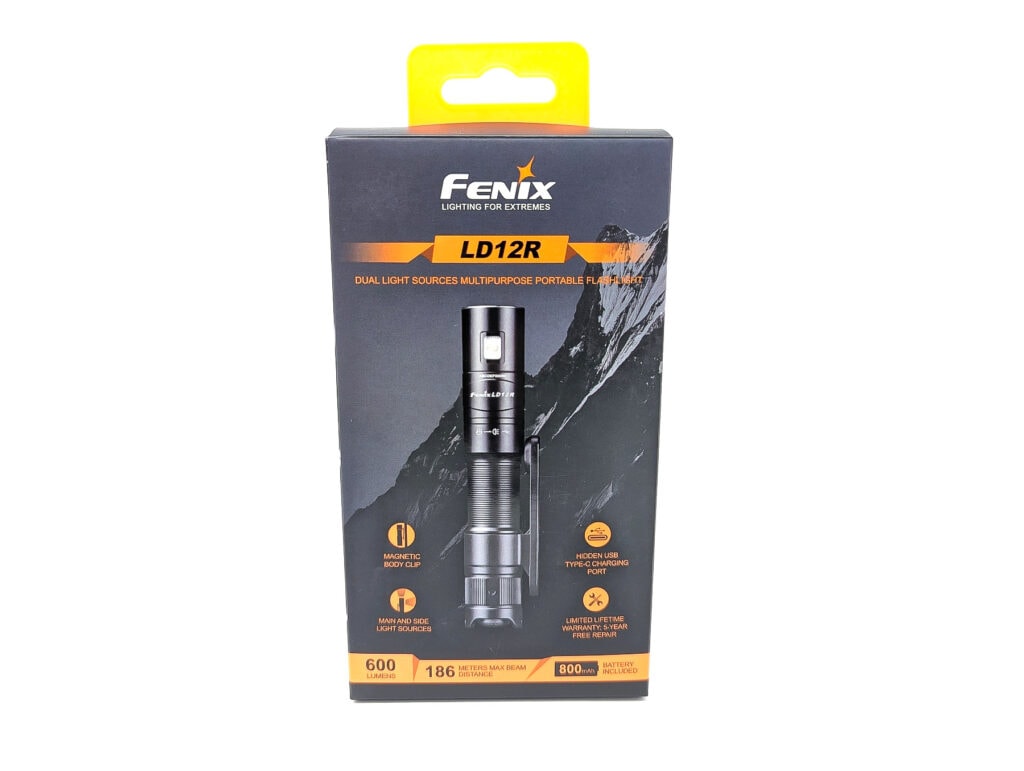
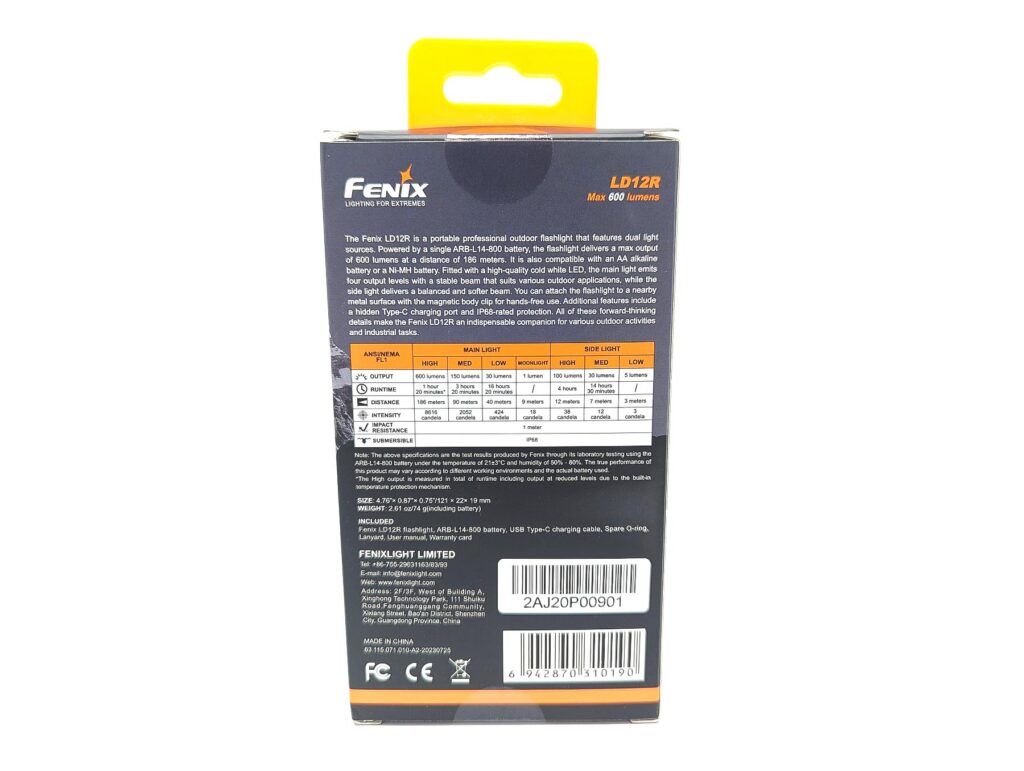
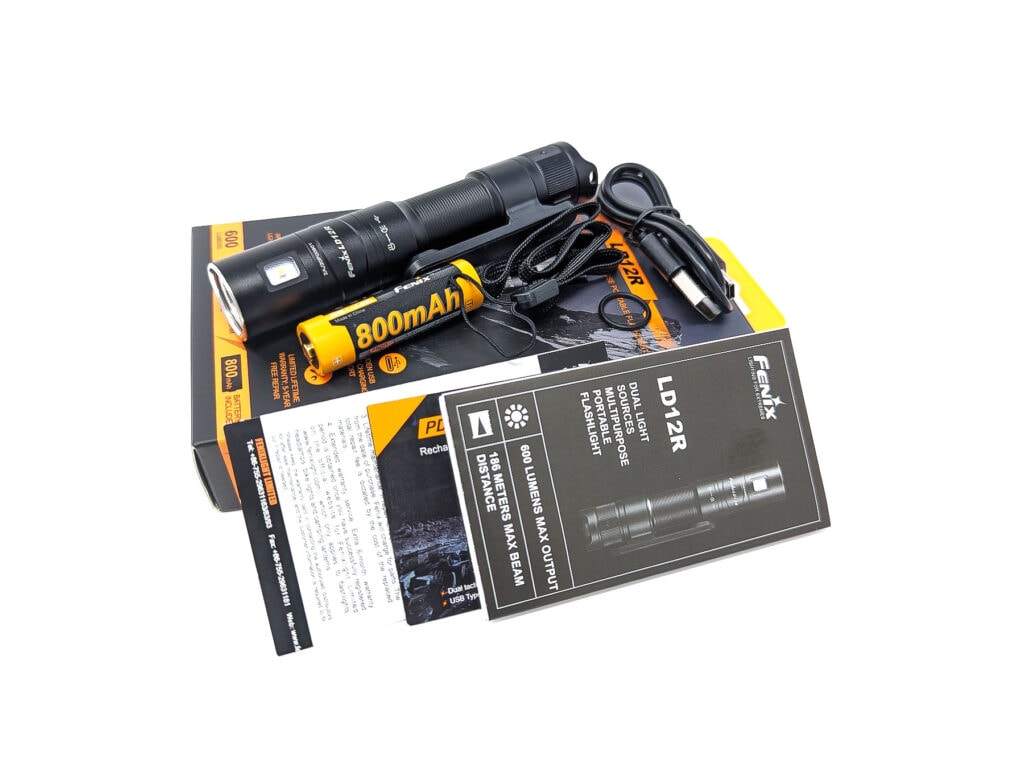
Flashlight in use, Build, and Warranty
I carry a 14500/AA flashlight in my pocket almost every day. That’s my chosen EDC form factor because they tend to be small enough, but can still pack a punch. While the Fenix LD12R is a 14500/AA flashlight, it’s not quite as compact as you might expect. It is fairly slender, but it’s just as long as the 18650-based Convoy S2+ and actually longer than the 21700-based Olight Baton 3 Pro Max. There are good reasons for the extra length, though – the LD12R features USB-C charging via a hidden port as well as a secondary side light.
The body of the Fenix LD12R is pretty smooth, allowing you to deploy it from your pocket with ease. Pocket retention is attained through an interesting pocket clip design. The clip itself appears to be constructed mostly of heavy-duty plastic, and the face of the clip has magnets embedded in it. The clip is captive on the body tube and gently glides around the body on a pair of O-rings. This allows you to use the magnets to hold onto any of a variety of ferrous surfaces, and then you can easily rotate the side light into position to fill a work area with light – it’s pretty handy.
You can also let the LD12R tail stand on a flat surface and use the side light to illuminate a picnic table or other work surface. This works reasonably well, but keep in mind that the flashlight is a bit tall and narrow, so it can topple over if you bump the surface that it’s standing on.
The body of the Fenix LD12R is the usual aluminum construction and then coated in premium HA Type-III hard anodizing. It has a light sheen to it, as is typical of Fenix lights. All in all, the construction is nicely executed and very clean.
Between the primary LED and the side light, the Fenix LD12R is pretty useful for a lot of everyday tasks – going for a walk, taking your dog out for a stroll, emergency lighting during a power outage, or perhaps reading a book with the well-diffused side light. I would add a caveat to that, though – I think of reading as a relaxing, wind-down kind of activity. Both emitters are cool white and anything but relaxing, they’re geared more toward task lighting unless CW is really your jam.
Warranty:
- 15 days from date of purchase: replacement from Fenix for manufacturing defects
- 5 year from date of purchase: free repairs
- Lifetime maintenance, with customer covering the cost of parts
- Extra 6 month warranty period for products registered on Fenix’s website
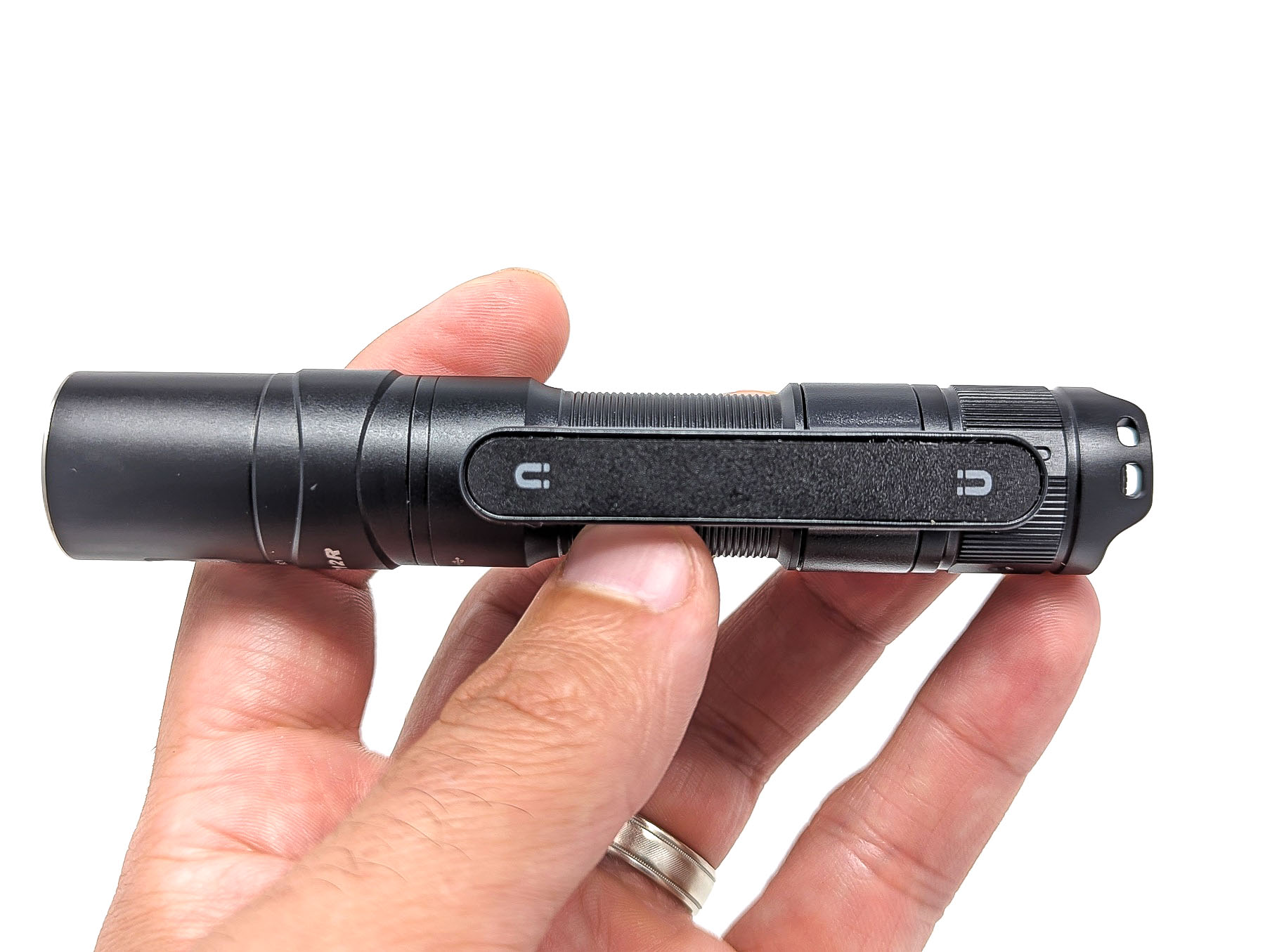
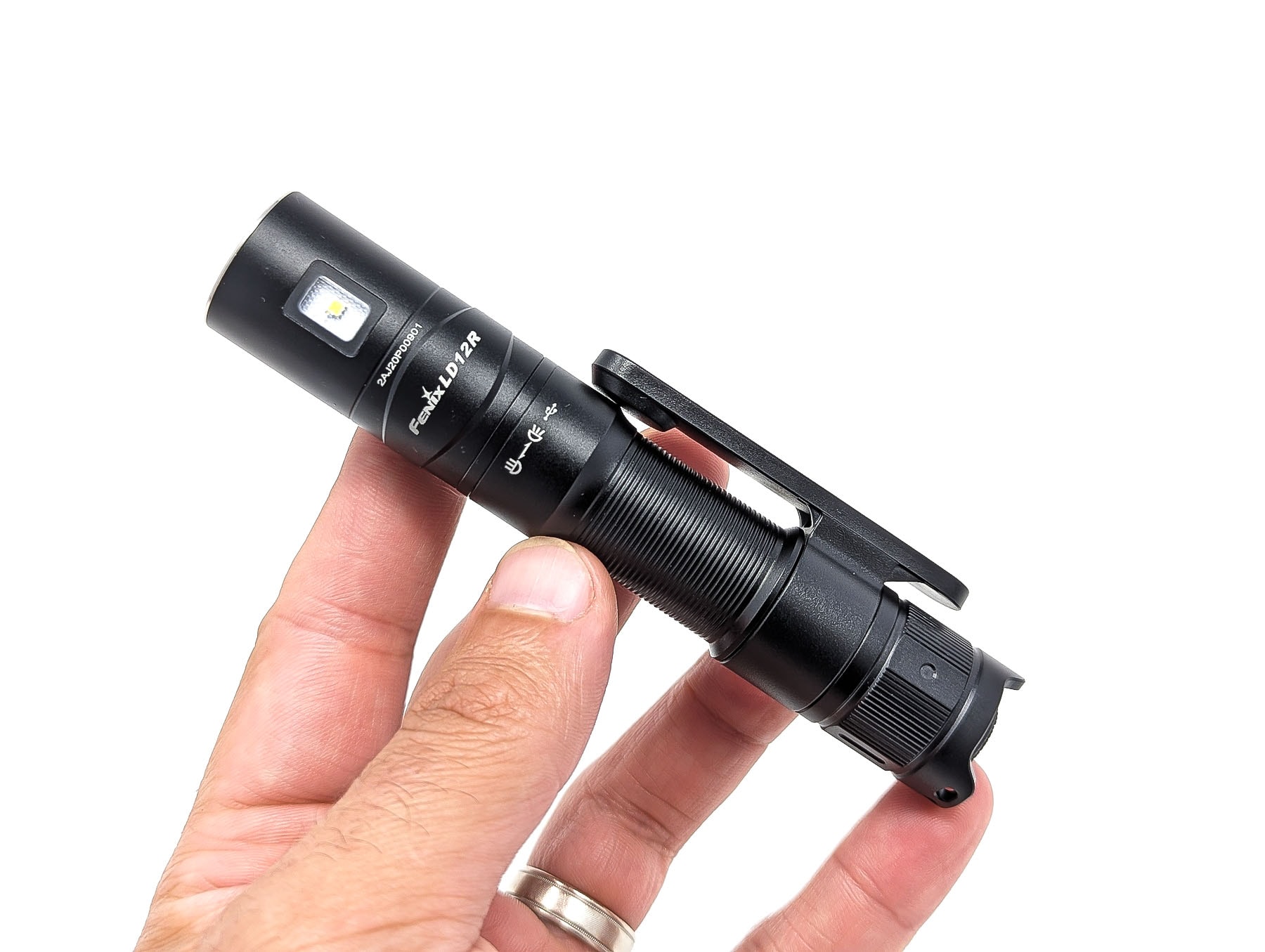
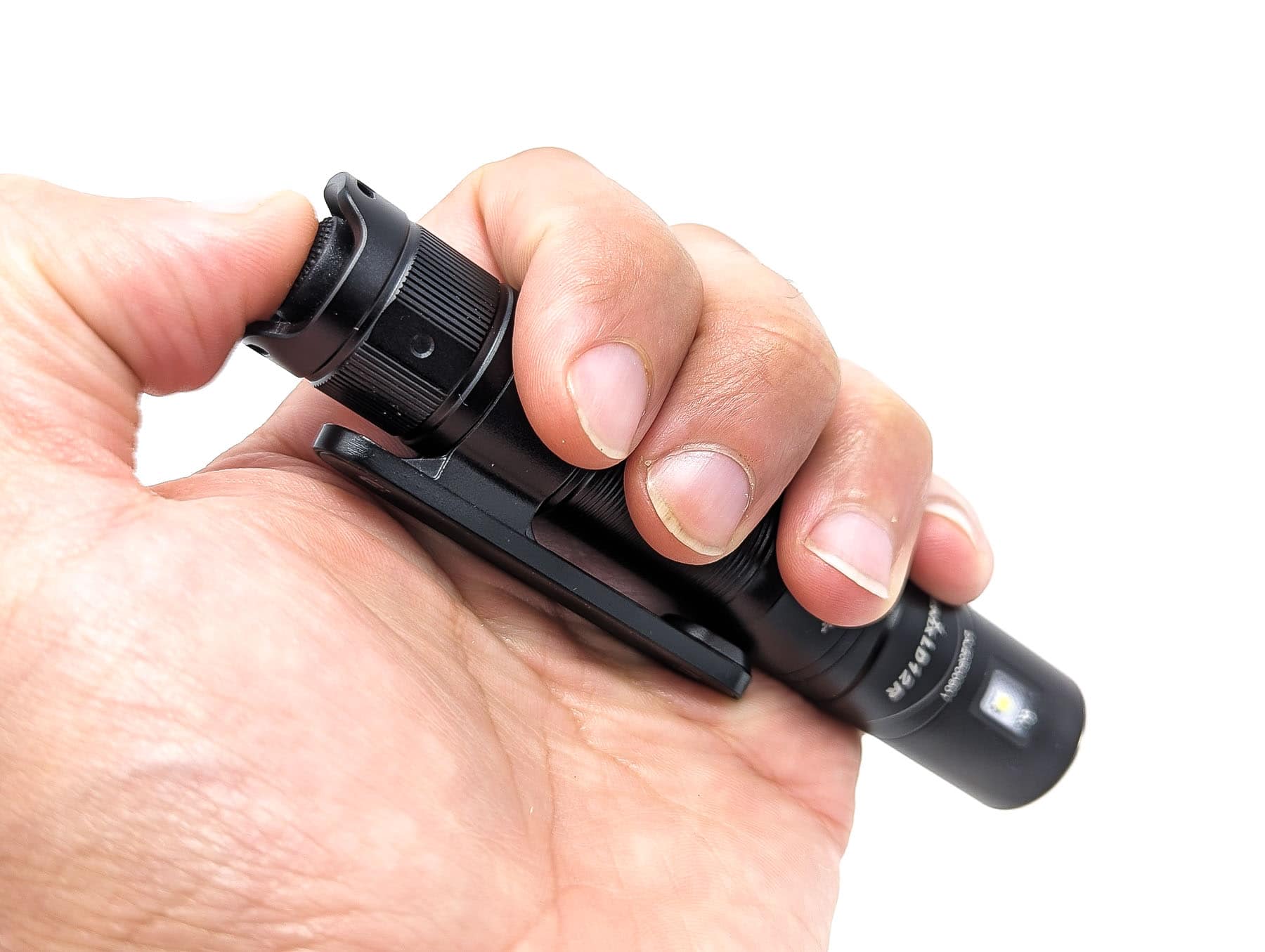
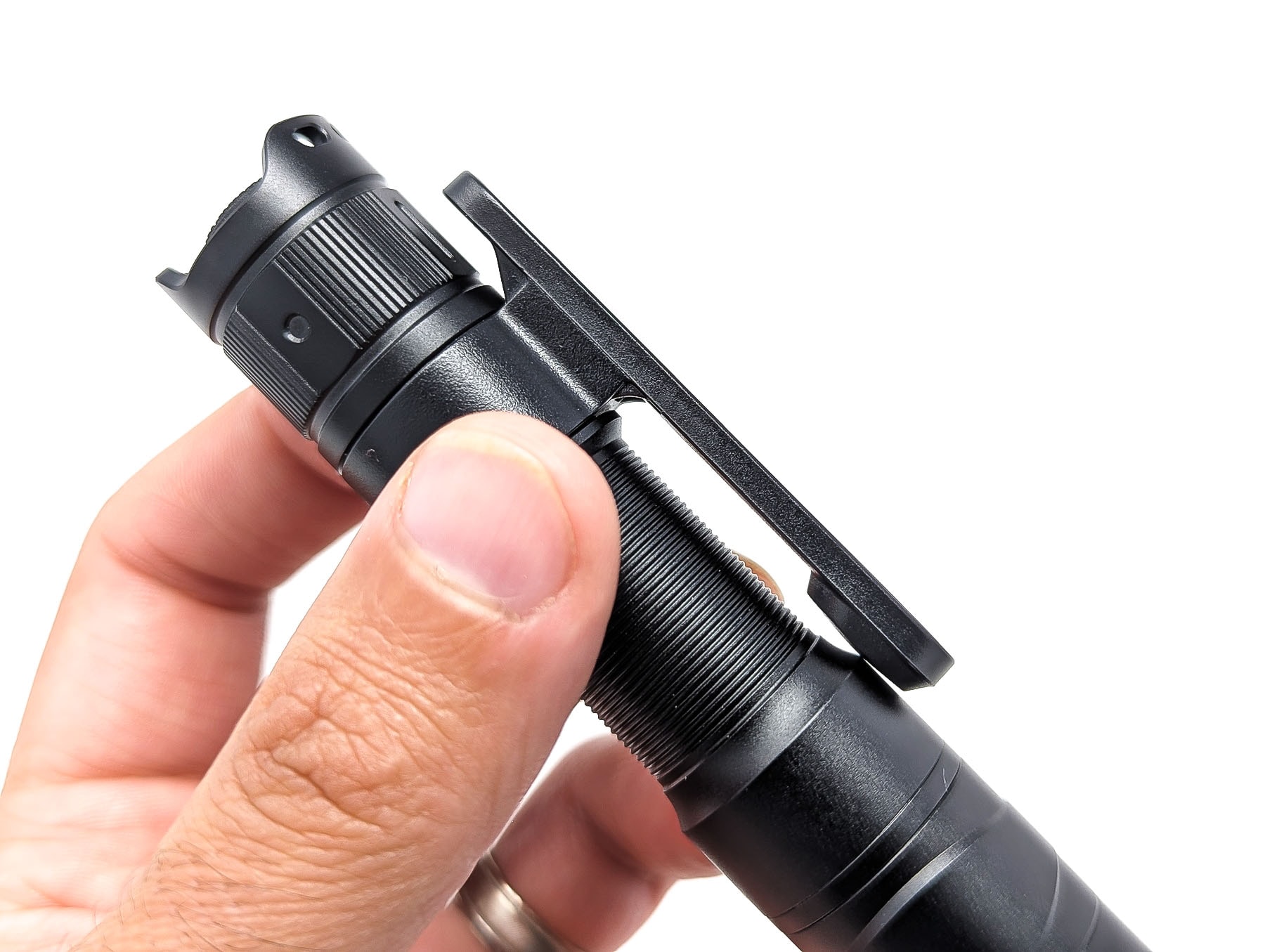
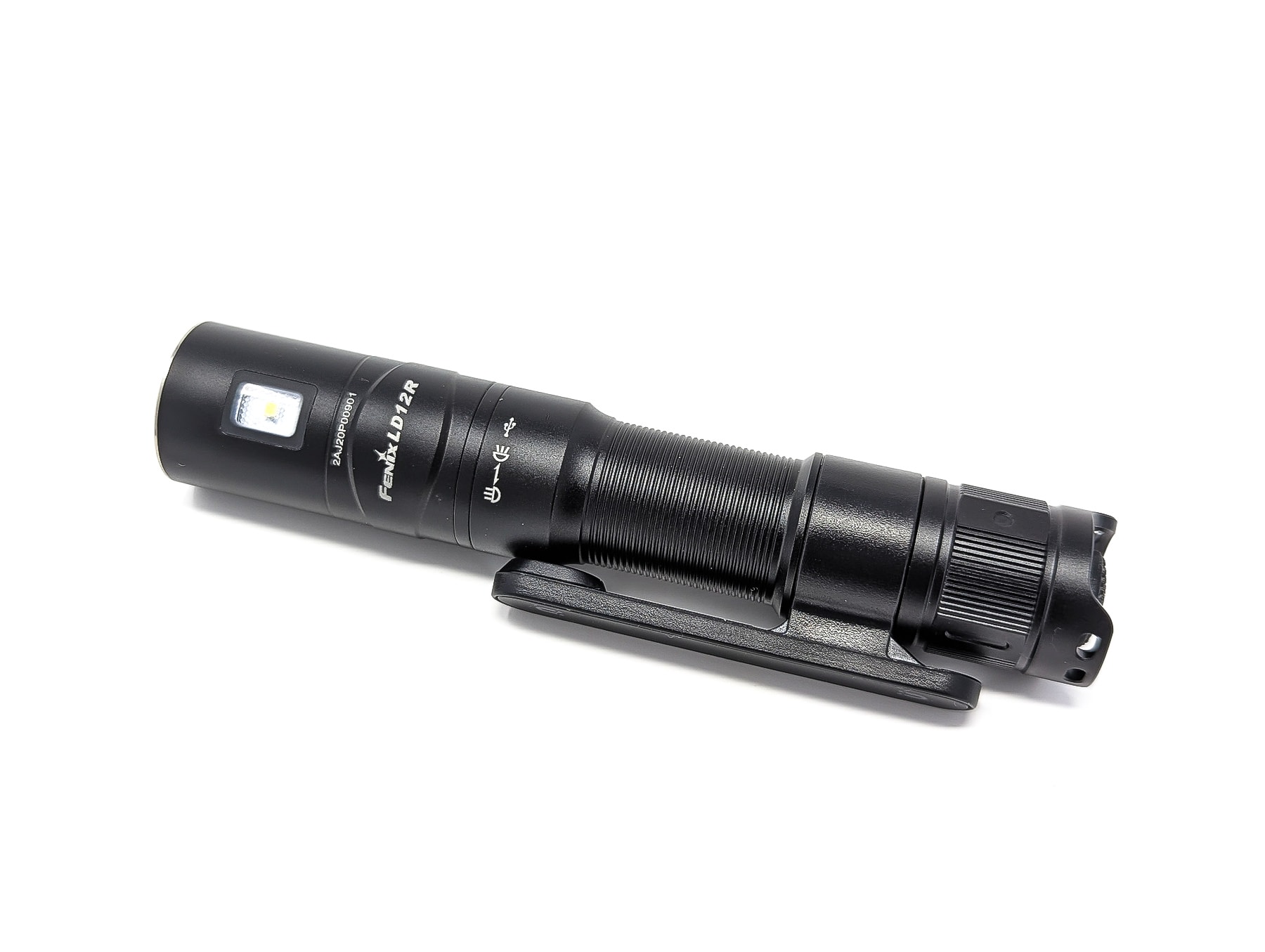
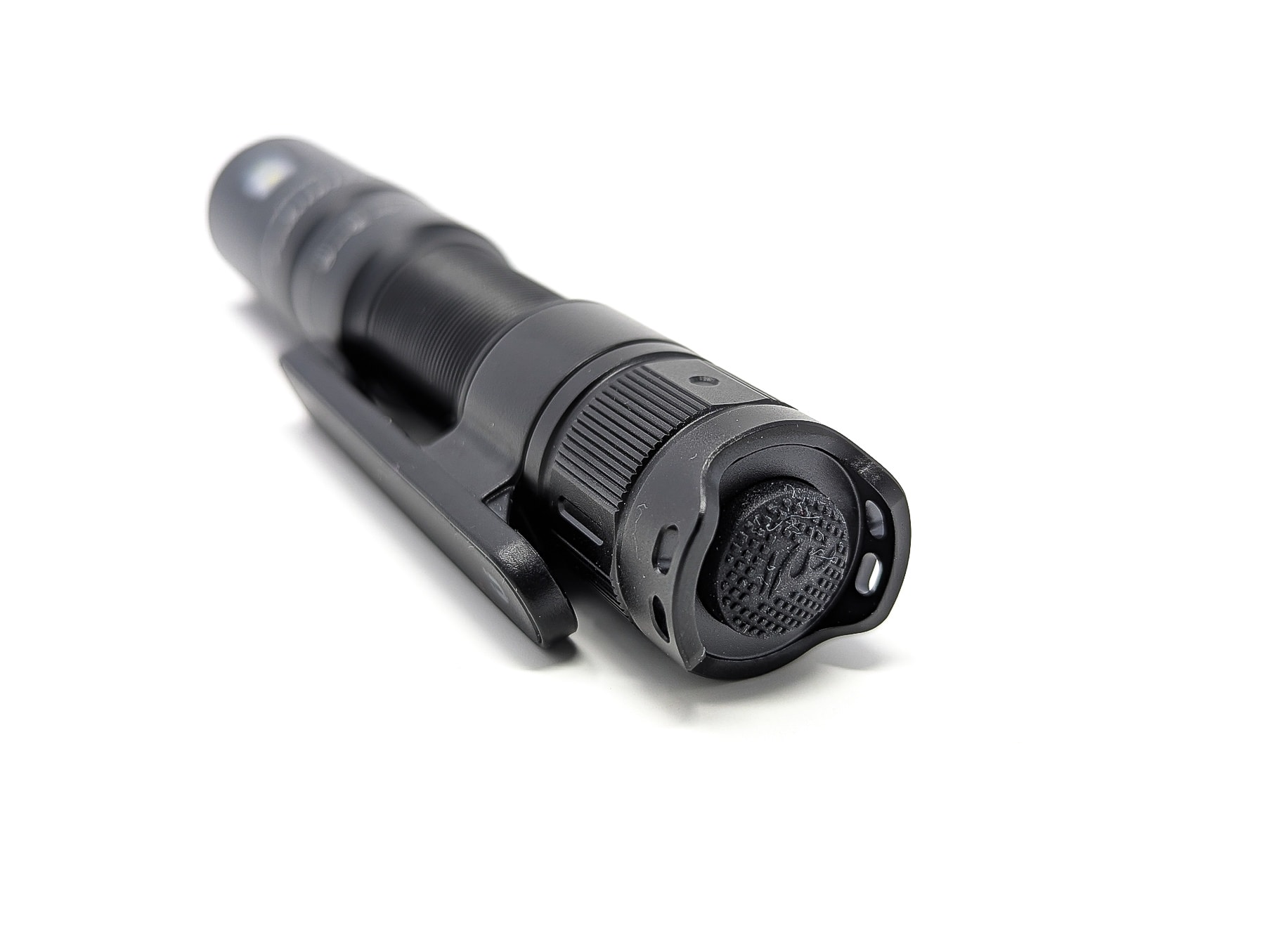
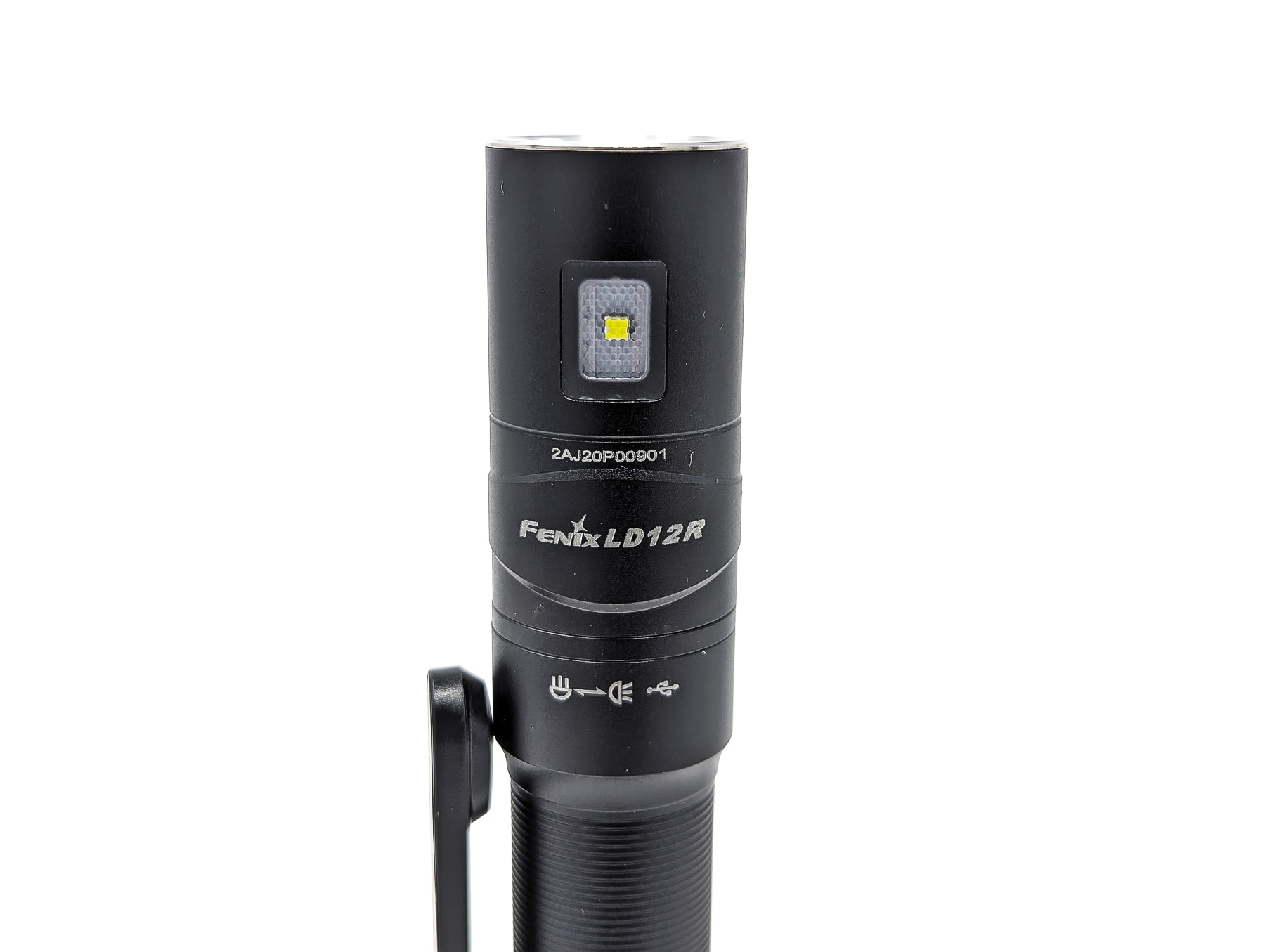
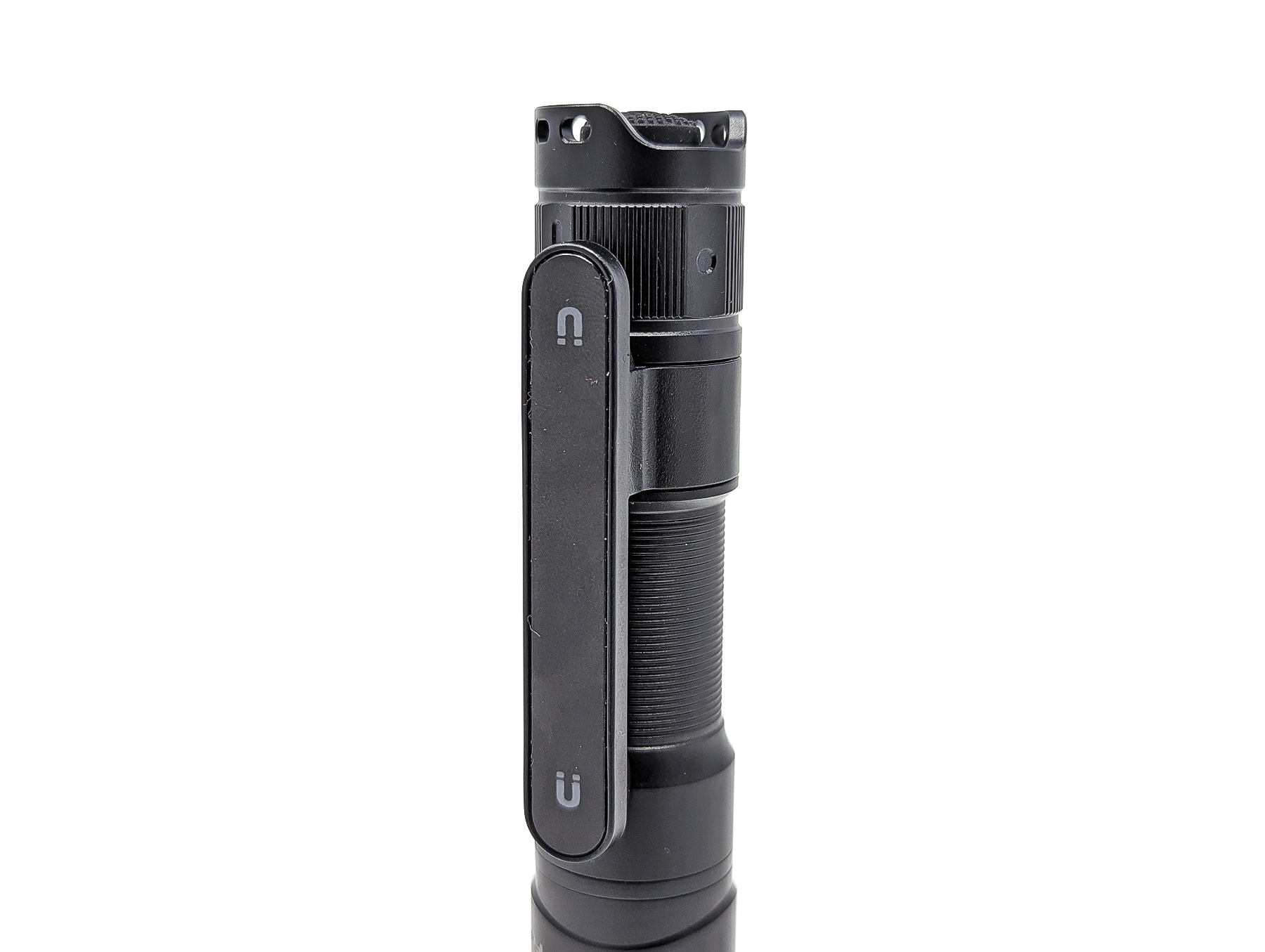
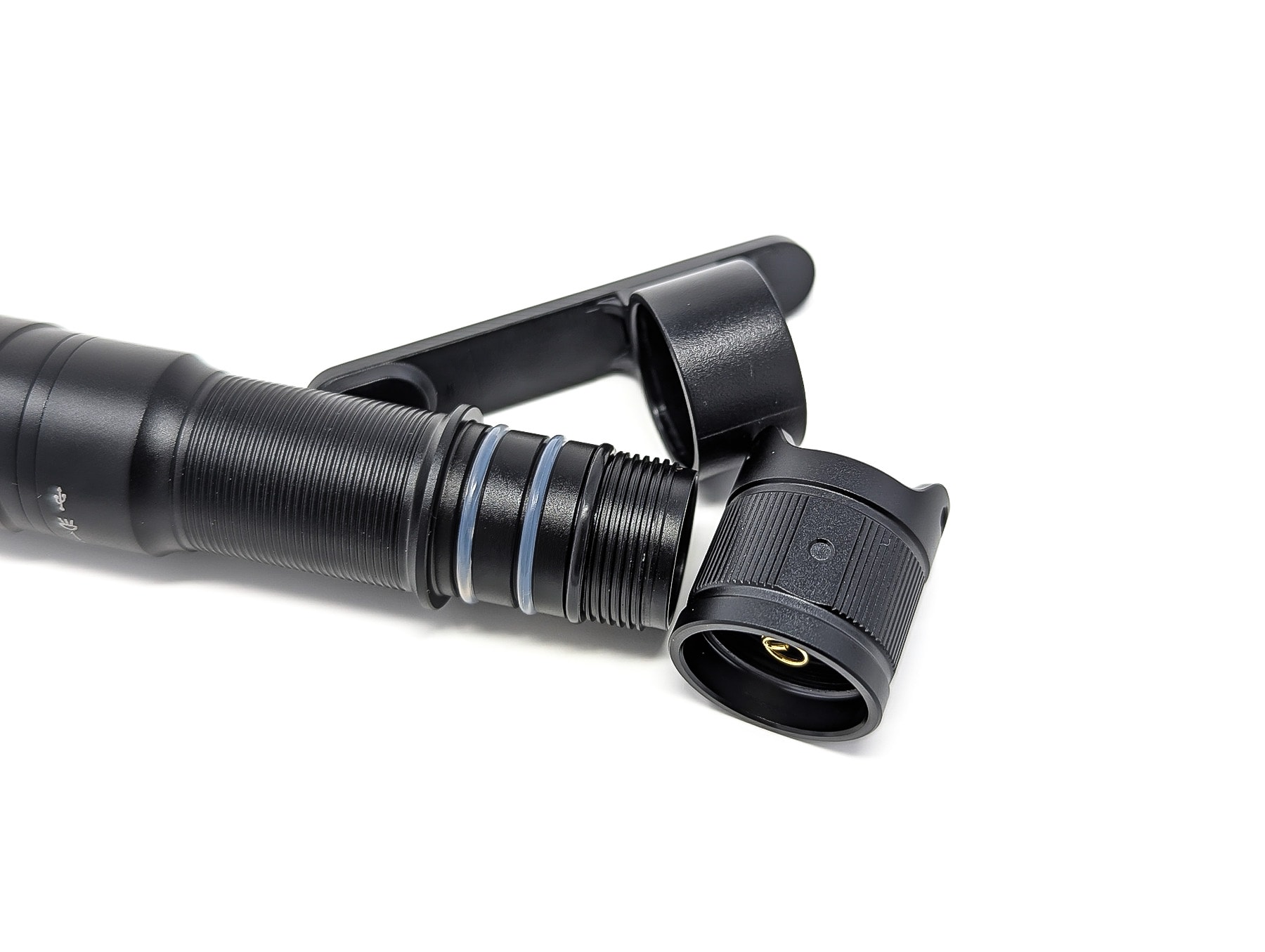
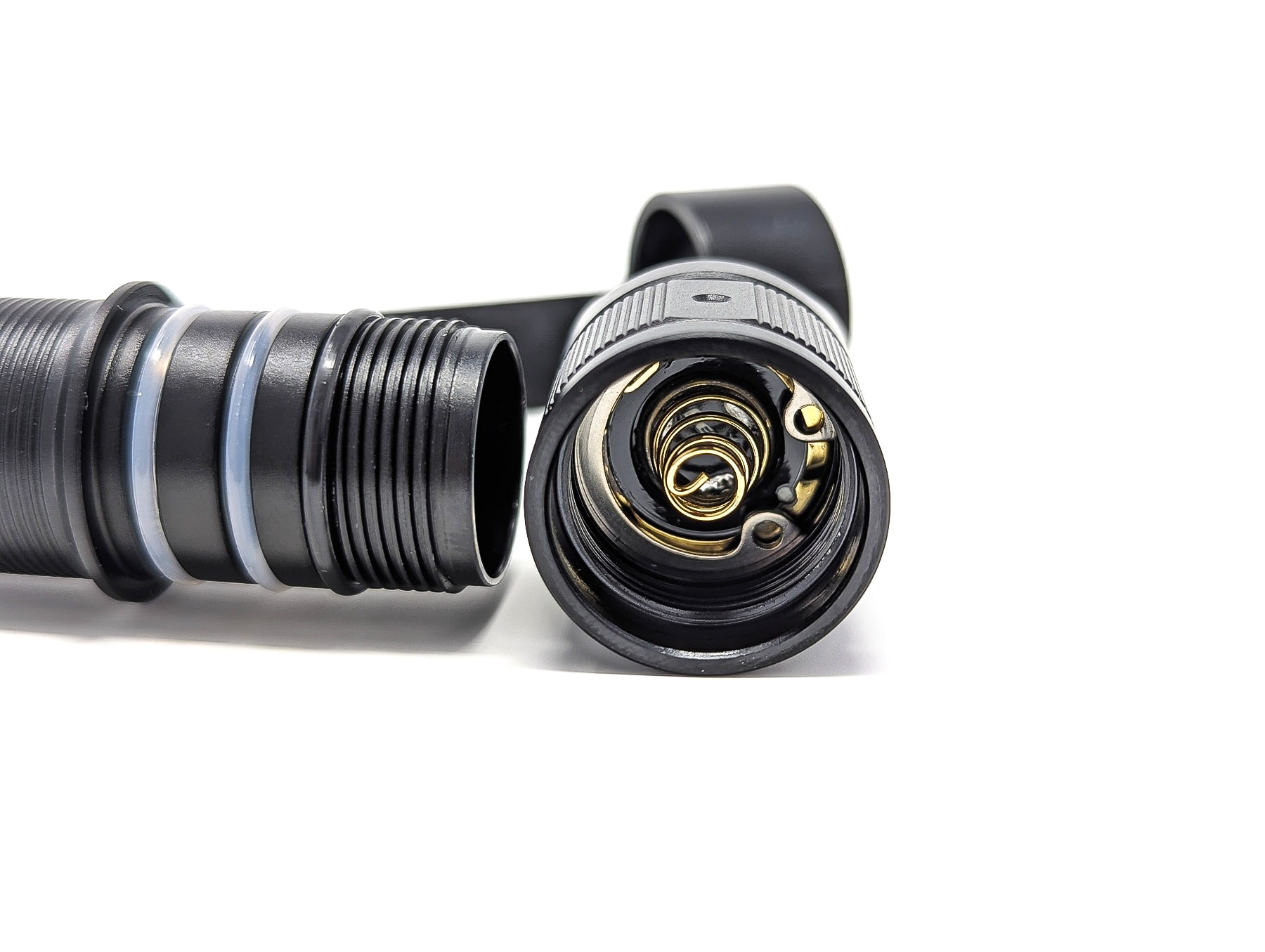
LED, Lens, Bezel, Beam, and Reflector
There are two different LEDs at work with the Fenix LD12R. The primary LED is a CW (~6500K) Luminus SST20. It sits up front behind a highly polished reflector. The reflector is kept clean by a piece of glass and a sleek stainless steel bezel – always a nice touch.
Fenix tells us that the side light is an SC1818C LED without mentioning who produces it. Googling doesn’t return much of anything helpful. So whatever it is, it’s tiny and hiding out behind a flat textured lens to help diffuse the beam, which is very wide and even. This auxiliary illumination is pretty handy, again assuming you don’t mind CW.
Spectral measurements:
I used an Opple Light Master 3 to measure the flashlight at 5 meters distance (at 1 meter for the side light).
| Mode: | CCT: | CRI Ra: | duv |
|---|---|---|---|
| High, main LED | 5624 K | 63.3 | +0.0114 |
| High, side LED | 6195 K | 70.4 | +0.0013 |
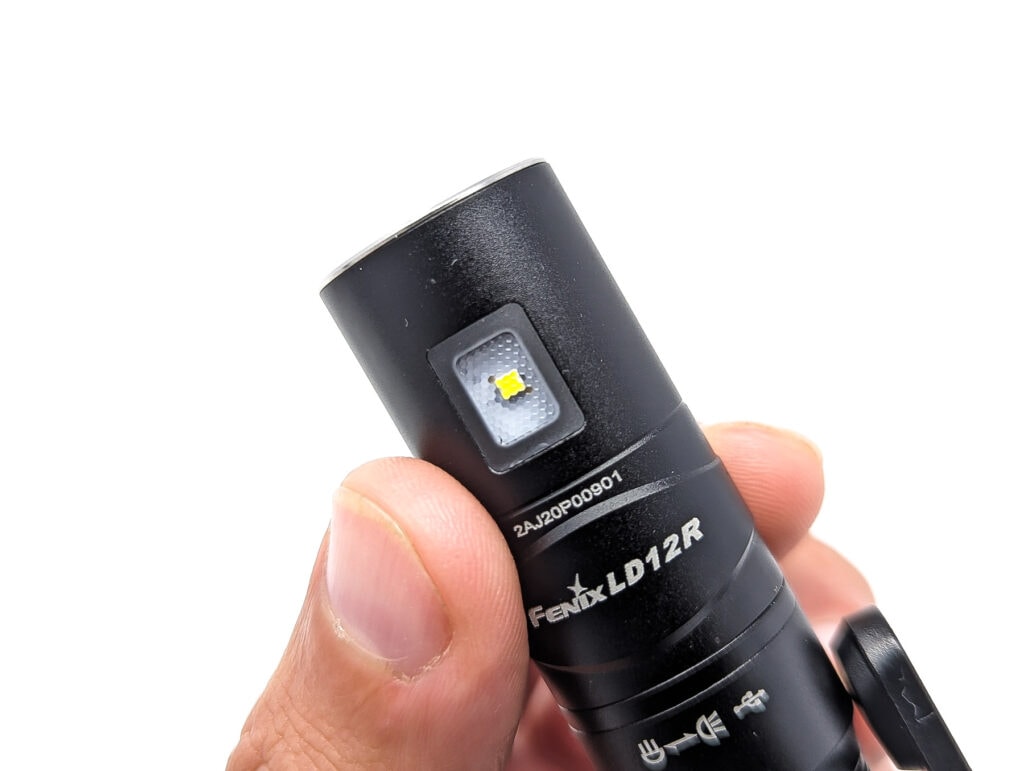
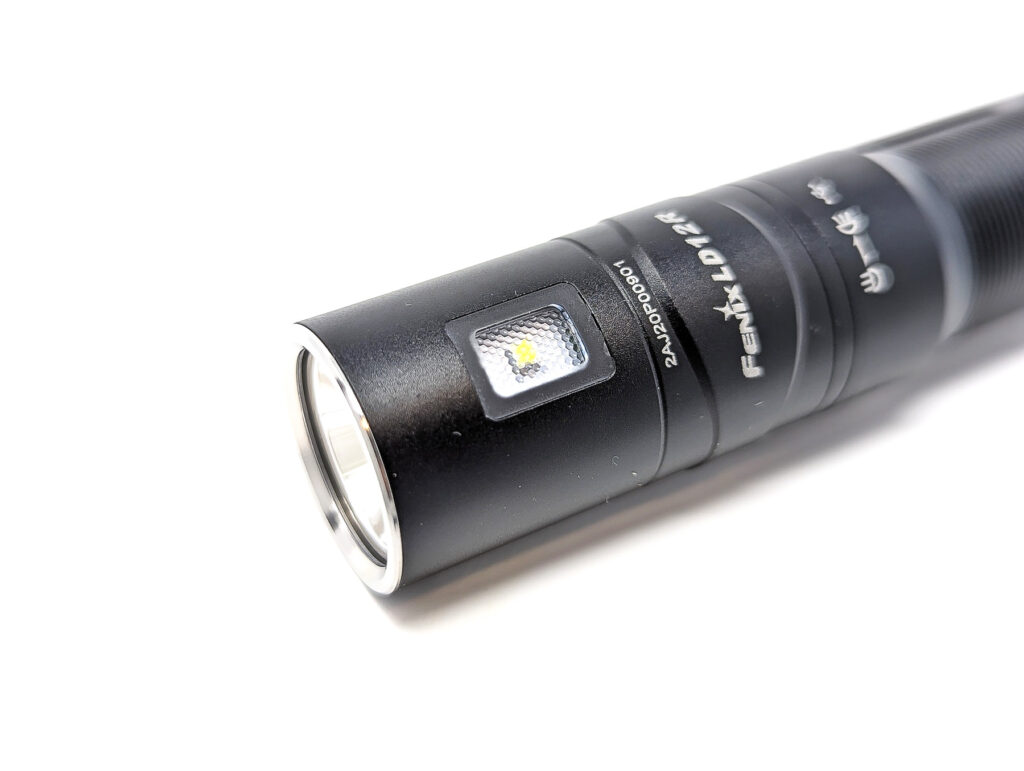
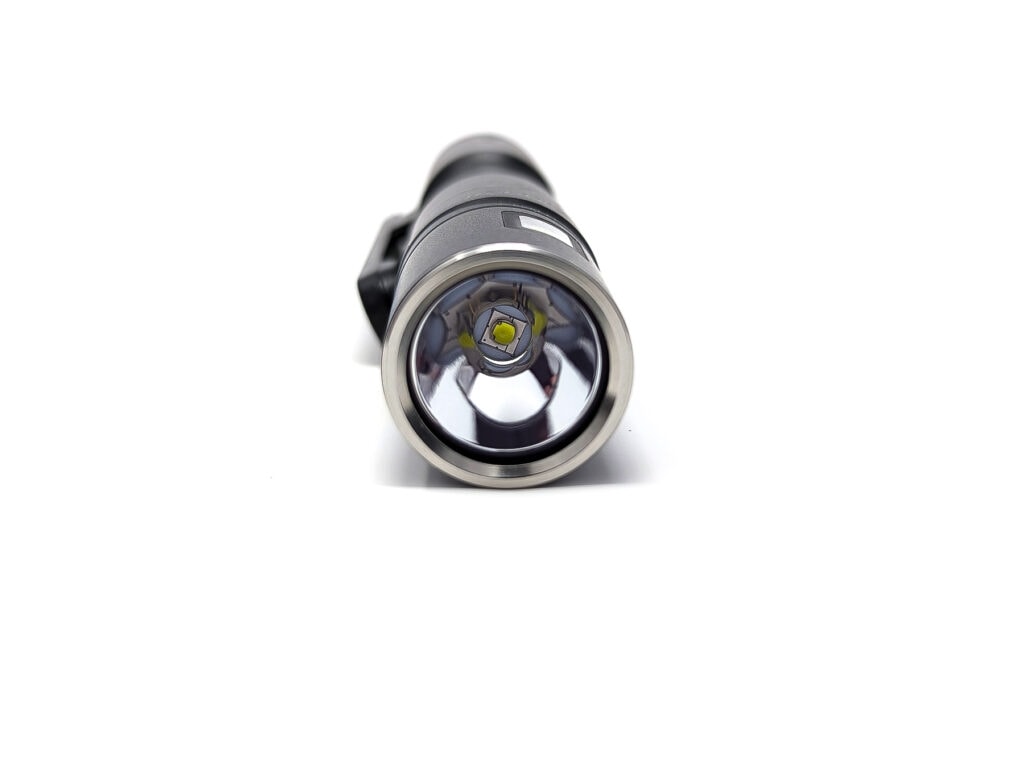
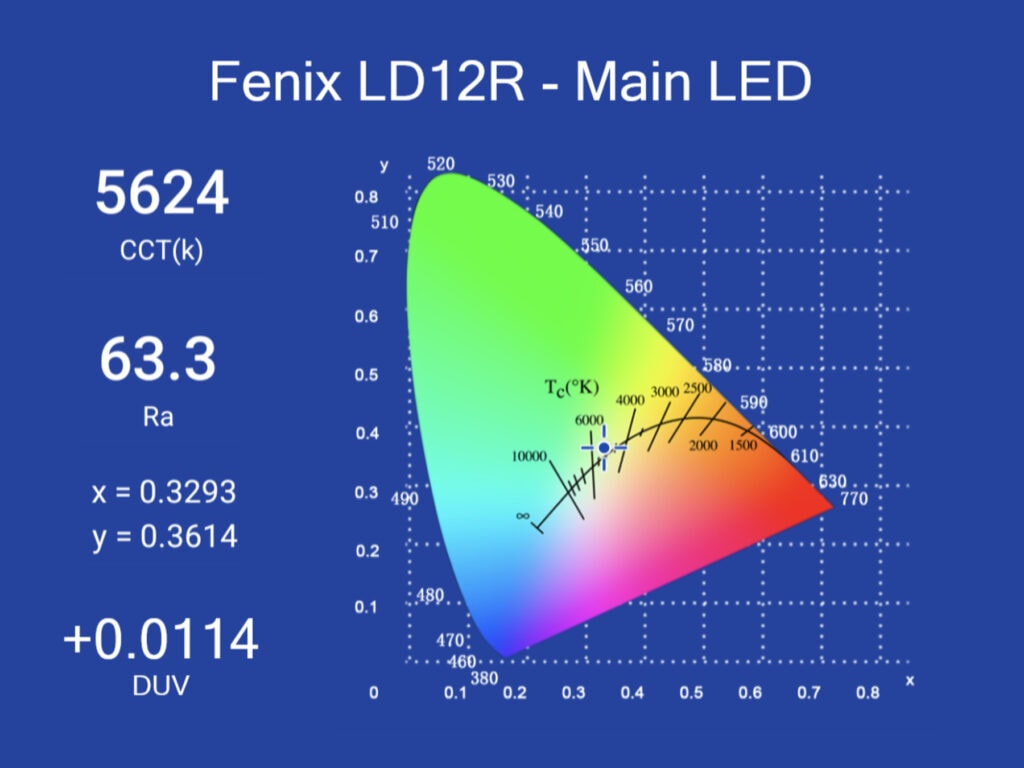
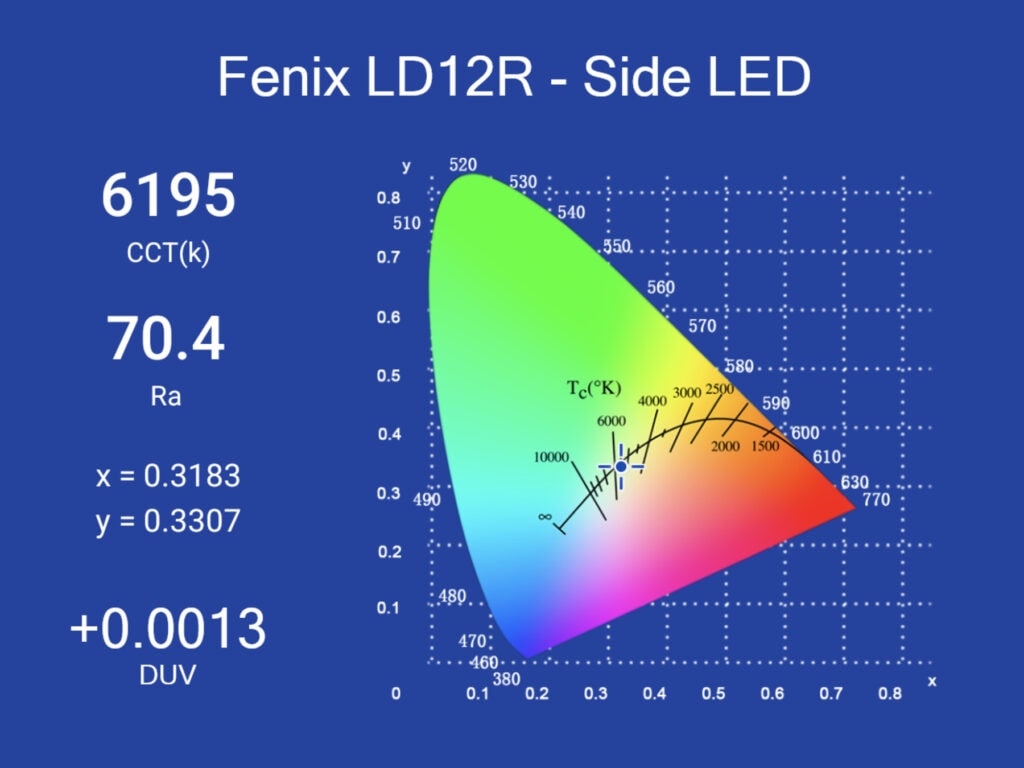
Dimensions and its competition
Dimensions:
| Fenix LD12R | Millimeters | Inches |
|---|---|---|
| Length | 121 mm | 4.8 in |
| Head diameter | 22 mm | 0.9 in |
| Body diameter | 19 mm | 0.7 in |
Weight:
| Fenix LD12R | Weight in grams | Weight in oz |
|---|---|---|
| Without battery: | 57 g | 2.0 oz |
| With battery | 76 g | 2.7 oz |
Flashlight size comparison with its competition:
Group 1: Convoy S2+, Fenix LD12R, Olight Baton 3 Pro Max
Group 2: Wurkkos TS10, Fenix LD12R, Olight Pokelit AA Cu
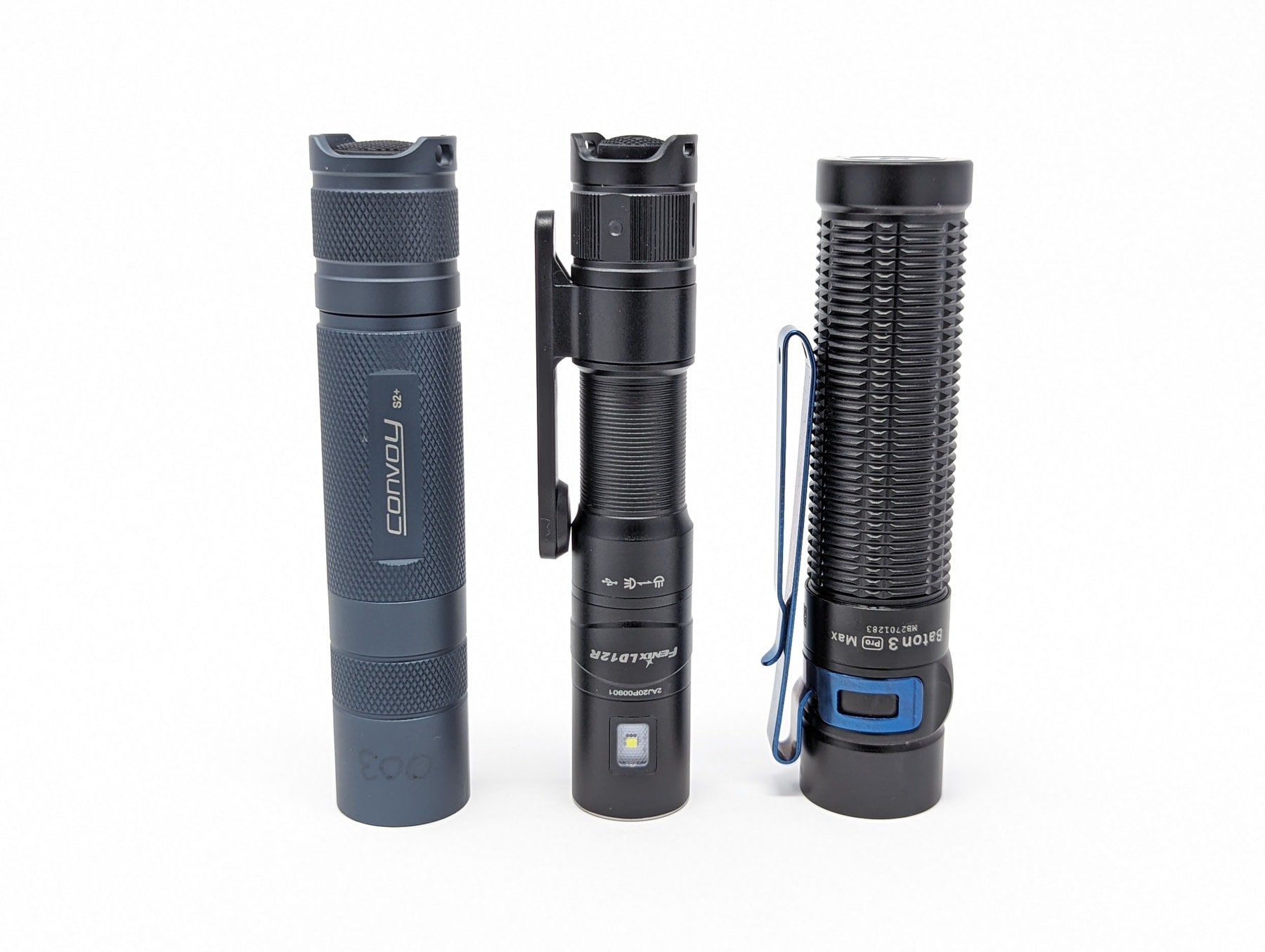
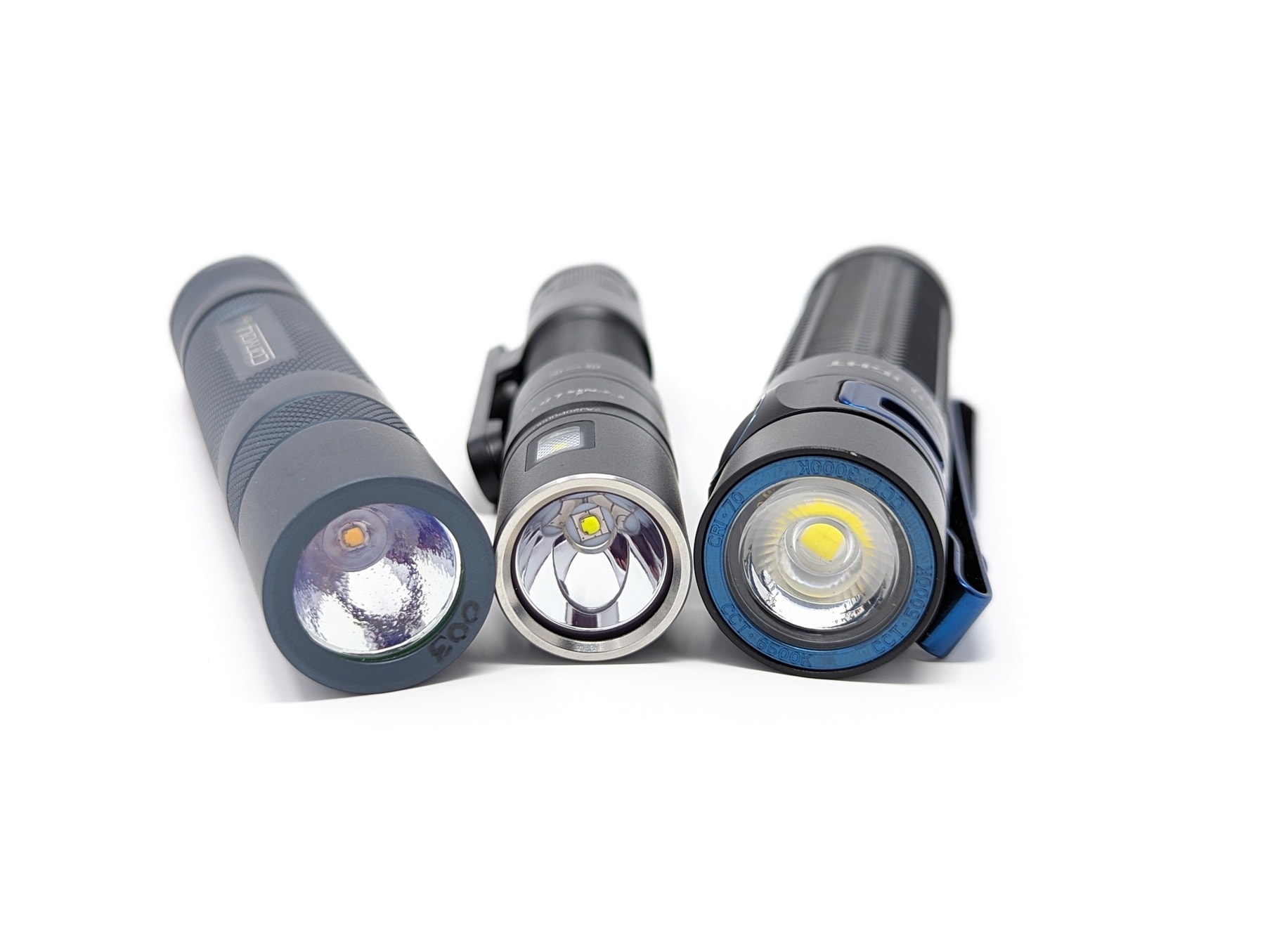
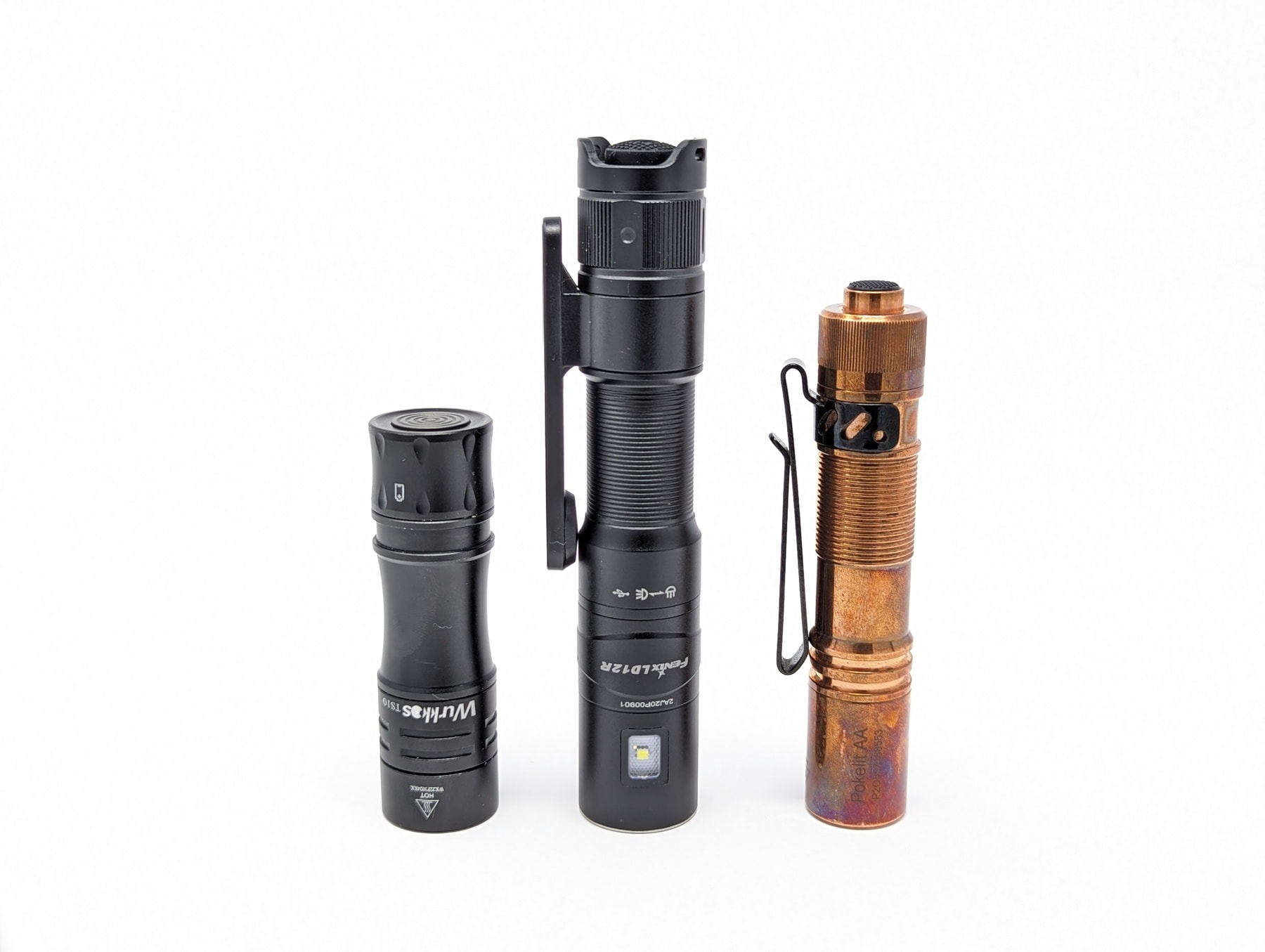
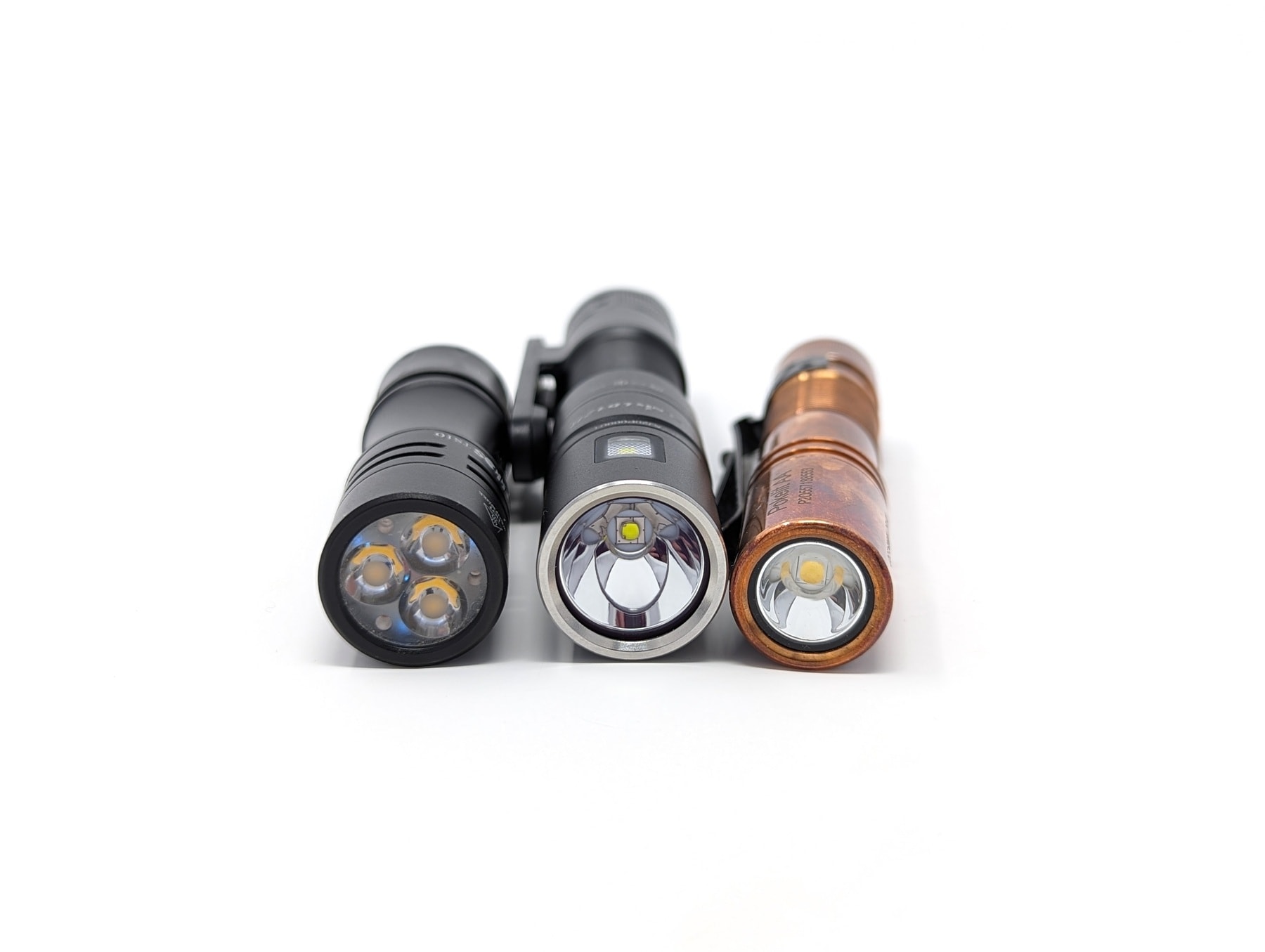
Fenix LD12R UI: User Interface and Driver
In general, the UI of the Fenix LD12R is really simple. It uses a reverse clicky switch to rotate through the brightness levels. But there’s a trick up its sleeve for switching between the main LED and the side light. The head unscrews to reveal a hidden USB-C charging port, however, it serves another purpose. If you unscrew the head and retighten it while the flashlight is turned on, it will switch between the two LEDs. Neat, eh?
Available modes:
- Main light: Moon, Low, Med, High
- Side light: Low, Med, High
Available blinky modes:
- N/A
From OFF:
- Single click: turn on
From ON:
- Single click: turn off
- Quick tap: change modes
- Twist head: switch LEDs
Mode memory:
- Yes, the main LED’s brightness is memorized
- Every time you turn the flashlight on it defaults to the main LED
- When switching to the side light, it always starts in Low
Shortcuts:
- N/A
Low voltage warning/protection:
- Output will step down when the battery gets low
- To check the battery level, unscrew the head and press the tail switch. An indicator LED to the left of the charging port will light up to indicate status:
- Green light on: 100% – 85%
- Green light flashes: 85% – 50%
- Red light on: 50% – 25%
- Red light flashes: 25% – 1%
- Note: this only works with lithium-ion batteries
Strobe/blinkies
- N/A
Lock-out mode:
- No electric lockout, but physical lockout is possible
PWM
- No PWM was detected (photodiode + DMM test)
Additional/summary info on the UI:
- High mode is not available when using AA batteries, it becomes a 3-mode light (for the main LED)
Fenix LD12R Charging and batteries
The Fenix LD12R comes with a Fenix-branded button-top 14500 lithium-ion battery, model ARB-L14-800. This included battery has a capacity of 800 mAh and features a protection circuit. The ARB-L14-800 battery is Fenix’s recommended power source, however, it is also compatible with other AA-sized batteries including alkaline, NiMH, and lithium primaries.
As expected, performance is much better with lithium-ion batteries than with the alkaline and NiMH batteries that I tried. I wouldn’t normally recommend alkaline batteries due to both the lack of performance as well as their tendency to leak and ruin the devices they’re kept in. Using a NiMH battery is perfectly acceptable, as long as you don’t need to use the High (~600lm) mode. In fact, this may actually be desired as sometimes you want to hand a flashlight over to a child or other individual who can’t be trusted with too many lumens.
The LD12R has a USB-C charging port that is hidden at the base of the head. Unscrew the head a bit to reveal the port. Note, built-in charging is only for lithium-ion batteries. There is an indicator LED next to the USB-C jack that lights up red when charging and switches to green when charging is complete. Fenix says that the charge time is approximately 2 hours, which is almost exactly what I observed with it’s 3.0W charge rate.
While I did not have a flat-top 14500 at hand to be able to test with, the driver-side contact is a flat plate with reverse polarity protection contacts on either side of it. I have my doubts that a flat-top 14500 would work in this light, though I have not confirmed that.
| Charge type | Fits | No fit | Charge time |
|---|---|---|---|
| Flashlight with onboard USB-C | Button-top 14500 (eg, non-protected button-top Epoch 1000mAh) Alkaline AA NiMH AALithium AA primaries | Flat-top 14500 (?) | 2h 2min |
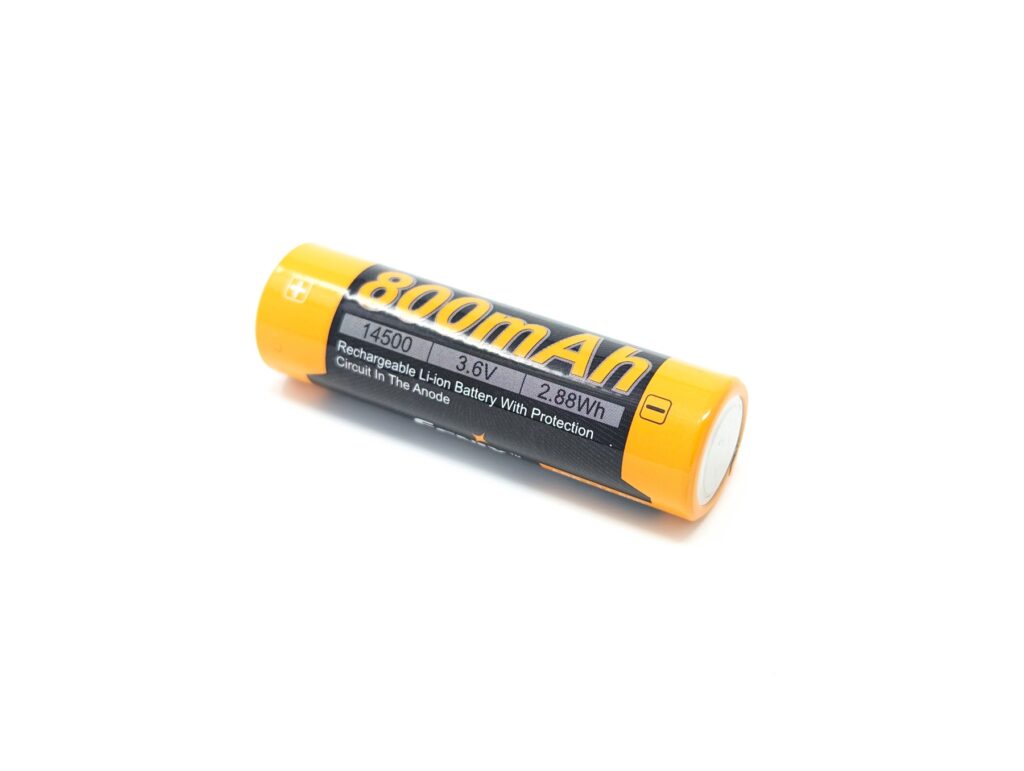
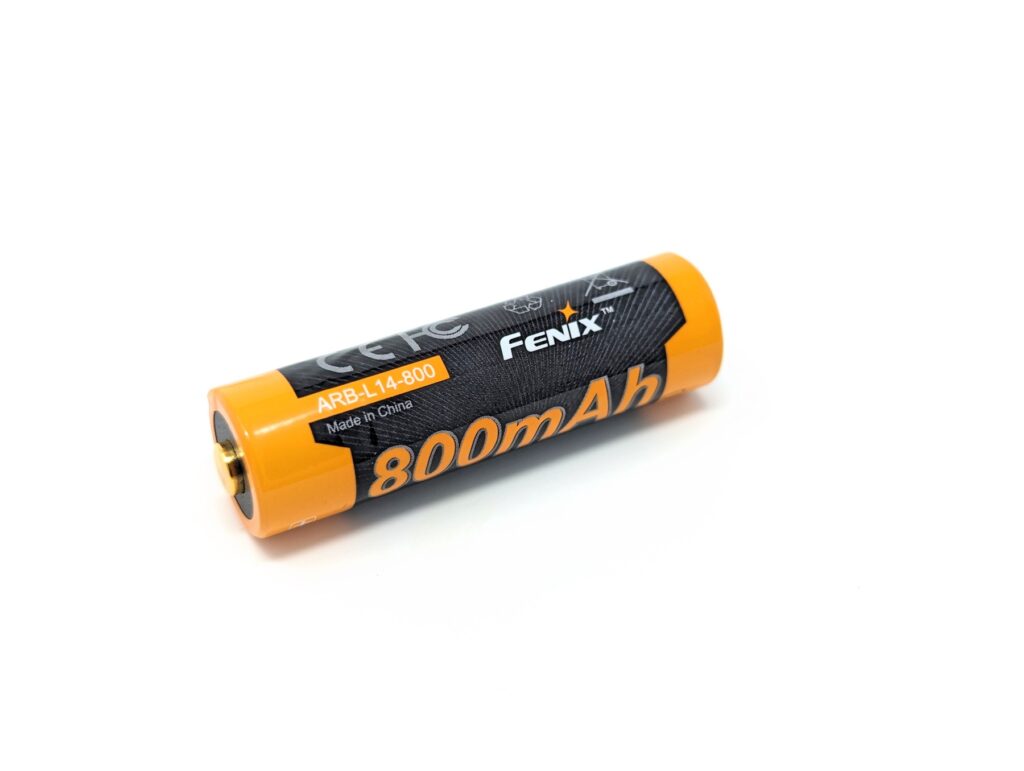
Performance test
Lumen measurements
How Lumens are Measured: Understanding ANSI FL1 Standards How Lumens are Measured: Understanding ANSI FL1 Standards: The ANSI FL1 standards specify that output in lumens should be measured 30 seconds after turning on, as this is the standardized time for measuring brightness according to the industry standard. This is why we focus on this part in our measurements. The ANSI FL1 standards require an ambient temperature of 22 ± 3°C. We record the ambient the ambient temperature to identify potential reasons for any observed discrepancies.Lux was measured by a UNI-T UT383 BT at 5 meters. Lumens were measured in a homemade lumen tube using a VEML7700 sensor, and calibrated with a calibration light provided by 1Lumen. The included Fenix battery was used for testing unless otherwise specified. In some tests, an Eneloop Pro AA and AC Delco Alkaline AA were also used.
| Mode | Amps at start | Specs | turn on | 30 sec | 10 minutes |
|---|---|---|---|---|---|
| Main LED, Moon | 7 mA | 1 lm | 1.3 lm | 1.3 lm | – |
| Main LED, Low | 50 mA | 30 lm | 30 lm | 30 lm | – |
| Main LED, Med | 260 mA | 150 lm | 133 lm | 132 lm | 132 lm |
| Main LED, High | 1.6 A | 600 lm | 679 lm | 665 lm | 317 lm |
| Main LED, Med, alkaline | – | – | 128 lm | 128 lm | 121 lm |
| Main LED, Med, NiMH | – | – | 128 lm | 128 lm | 129 lm |
| Mode | Amps at start | Specs | turn on | 30 sec | 10 minutes |
|---|---|---|---|---|---|
| Side LED, Low | 14 mA | 5 lm | 3.4 lm | 3.3 lm | – |
| Side LED, Med | 62 mA | 30 lm | 20 lm | 20 lm | – |
| Side LED, High | 210 mA | 100 lm | 61 lm | 61 lm | 61 lm |
| Turbo at 3.6V | – | – | 562 lm | 531 lm | – |
Parasitic drain:
- N/A – clicky switch design
One of the biggest performance questions, in my mind, is “Does it hit the biggest claims?” With the LD12R, I would say it does. It punches a little above the 600-lumen claim for High mode from the main LED. The rest of the main light modes are pretty darn close to spec, too. Where things seemed to fall short was the lumen output of the side light. I didn’t measure anywhere near the Fenix claim, which is a bit unusual. But this is an auxiliary LED we’re talking about, so I’m not too concerned about it.
Fenix LD12R Battery Life: Runtime graphs
How Runtimes are Measured: Understanding ANSI FL1 Standards About ANSI FL1 runtime standards: The runtime is measured until the light drops to 10% of its initial output (30 seconds after turning on). This does not mean that the flashlight is not usable anymore. The last column shows how long the light actually works till it shuts off. If there is a + symbol, it means that the test was stopped at that particular point, but the light was actually still running. This happens on certain occasions, with certain drivers, firmware, or batteries.| Mode | Specified runtime | Measured runtime ANSI | Time till shut off |
|---|---|---|---|
| Main LED, Moon | N/A (not specified) | – | – |
| Main LED, Low | 16h 20min | – | |
| Main LED, Med | 3h 20min | 3h 7min | 3h 9min+ |
| Main LED, High | 1h 20min | 1h 10min | 1h 22min+ |
| Main LED, Med, alkaline | – | 35min | 1h 11min+ |
| Main LED, Med, NiMH | – | 2h 2min | 2h 18min+ |
| Side LED, Low | N/A (not specified) | – | – |
| Side LED, Med | 14h 30min | – | – |
| Side LED, High | 4h | 3h 54min | 4h 38min+ |
In general, my battery life tests line up well with Fenix’s claims. They didn’t provide any specs that are specific to alkaline or NiMH, so I didn’t have anything to compare those to. I would say that, while I only used a so-so-quality alkaline battery, alkaline performance was abysmal. I would only use alkaline batteries in an emergency “nothing other options” scenario. Runtime with NiMH was much better, matching the lumen output of the lithium-ion cell while retaining 67% of the battery life.
Note: after stepping down to ~1.7 lumens, the light continued to shine for an extended period.
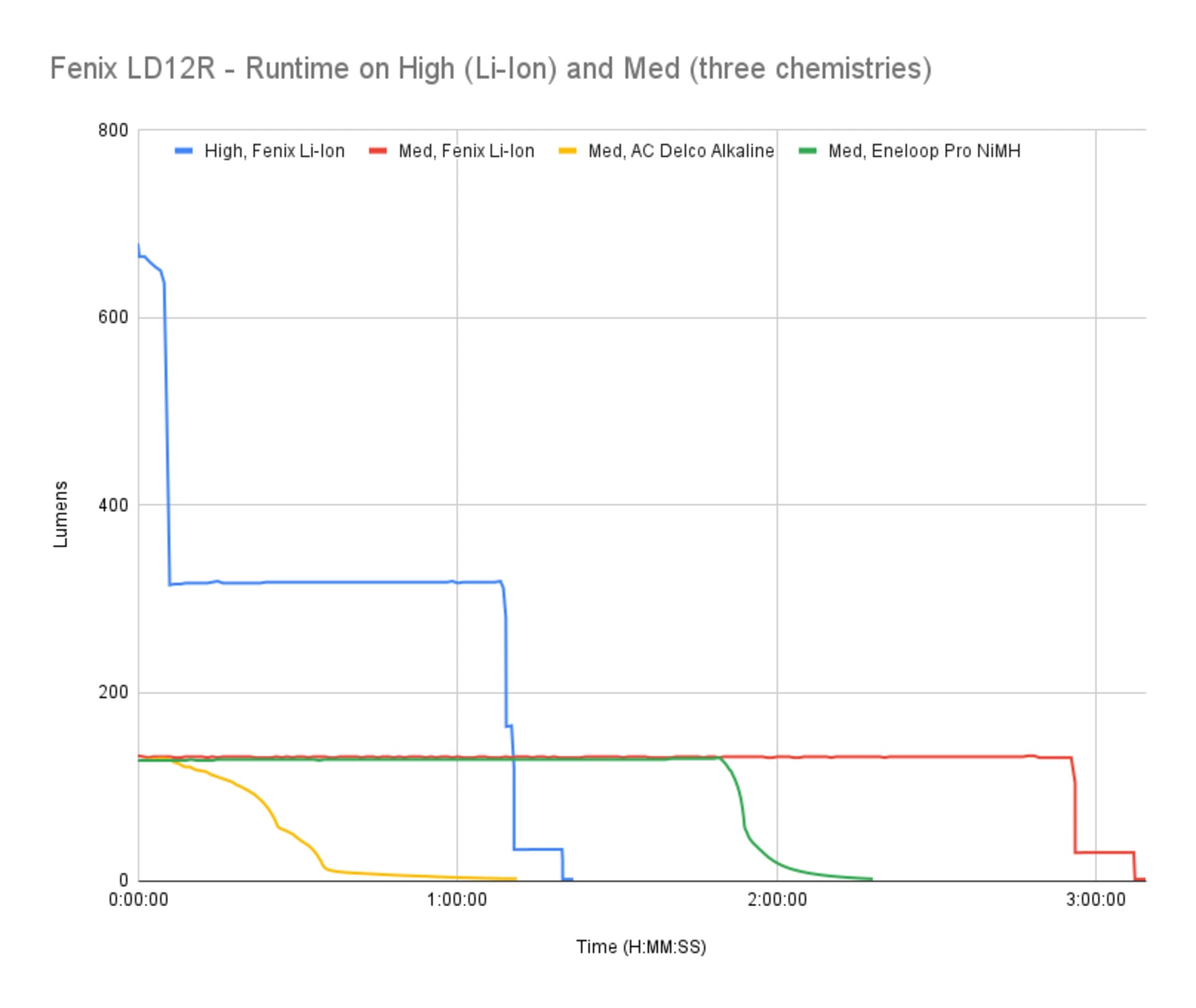
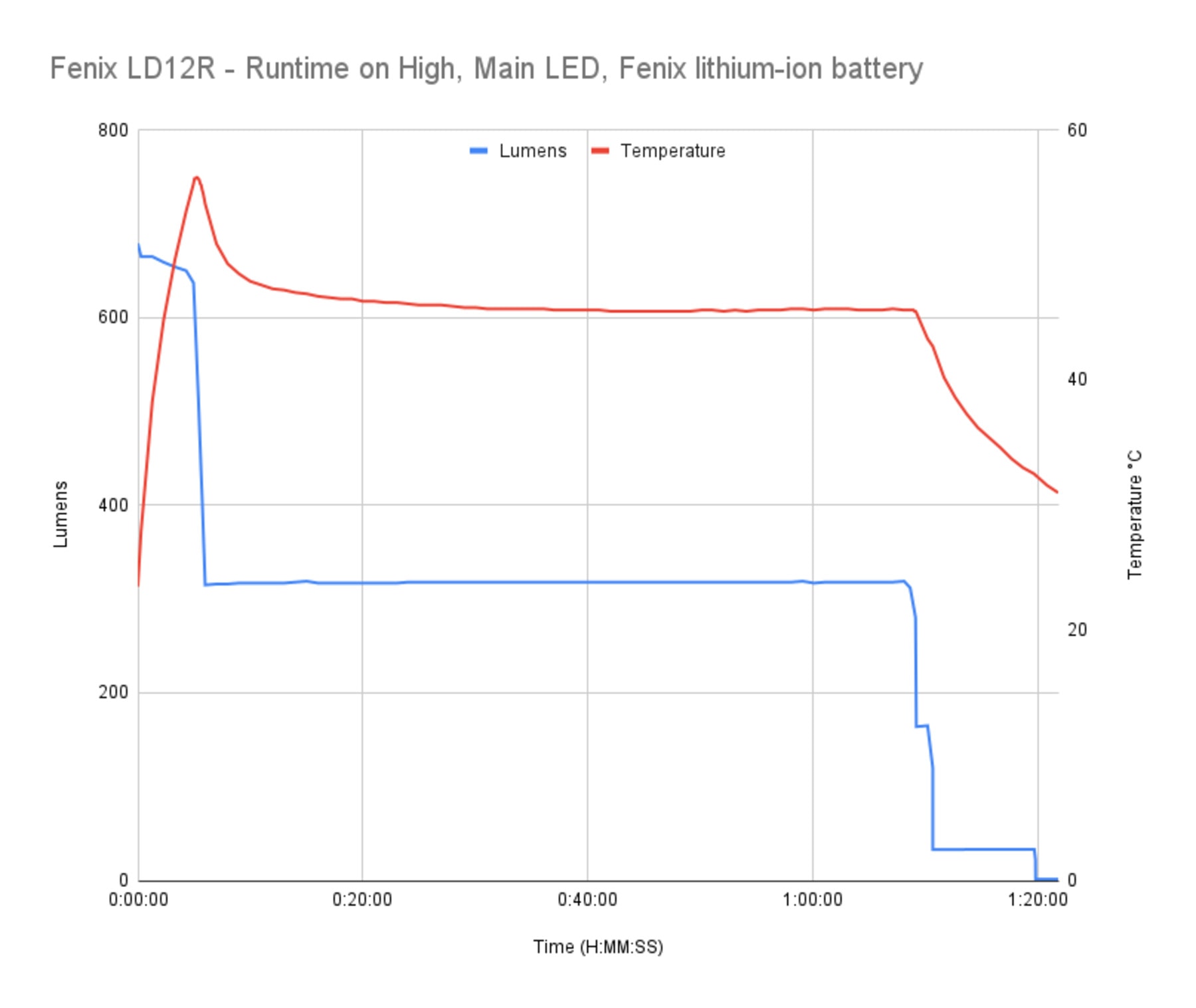
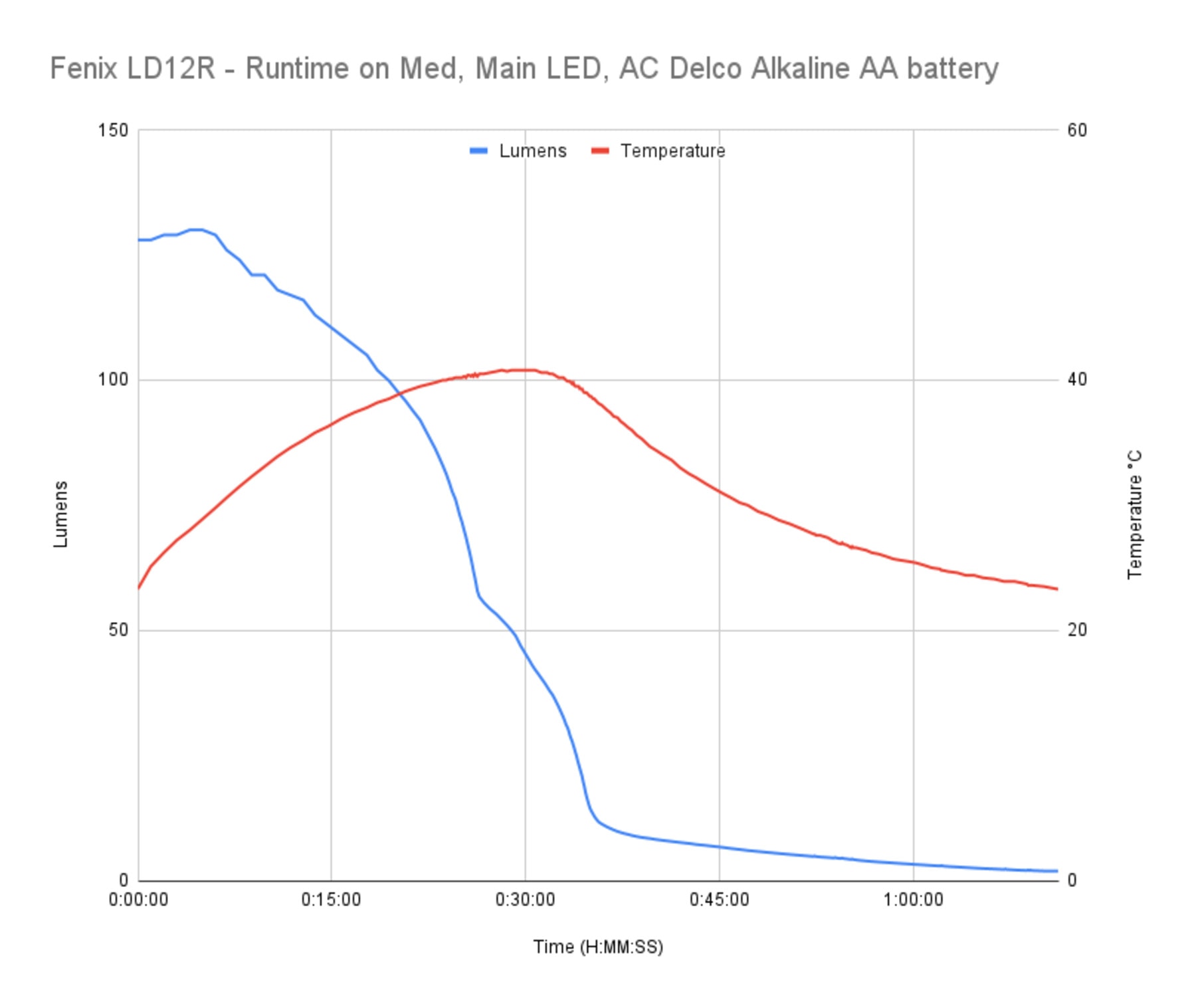
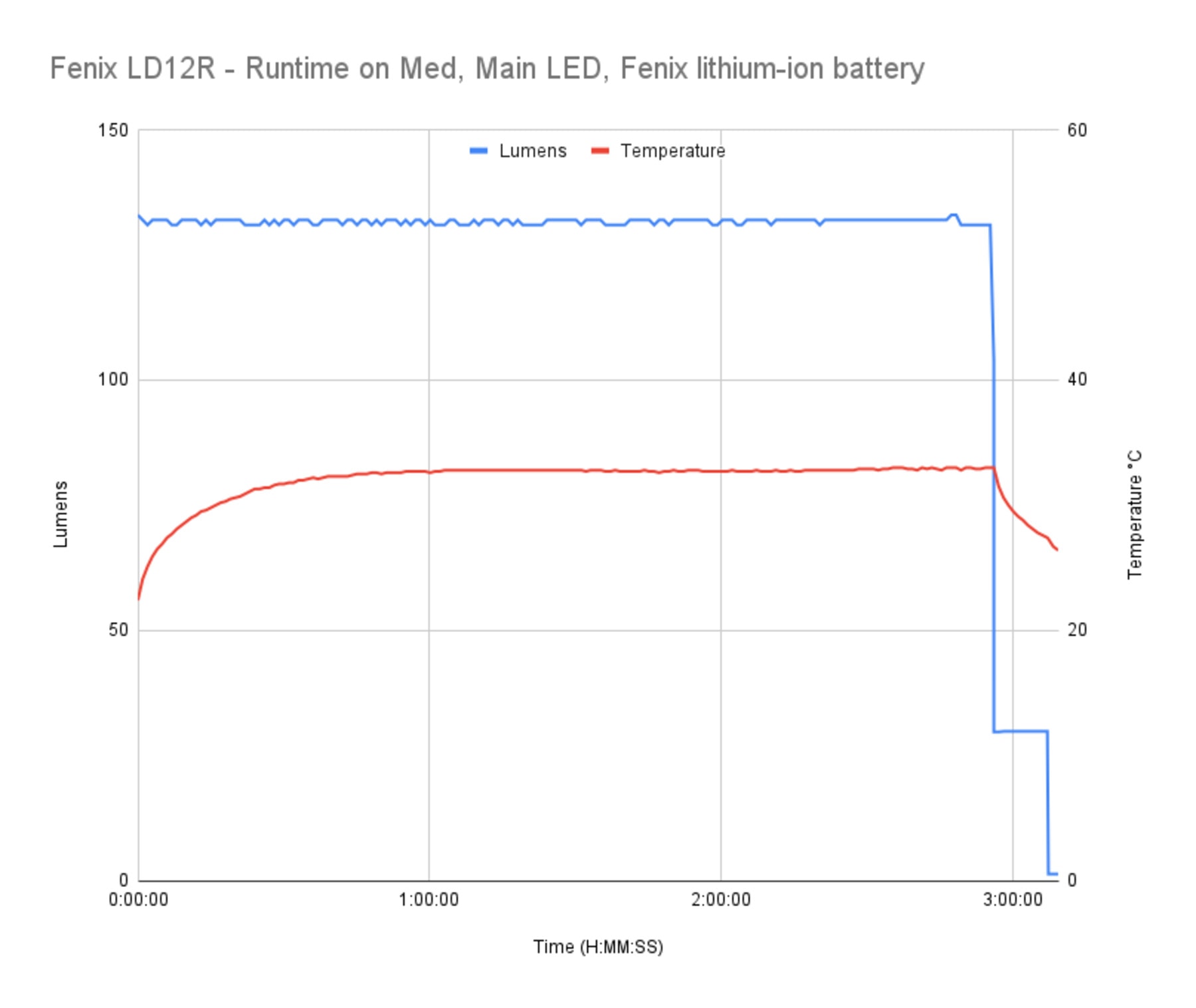
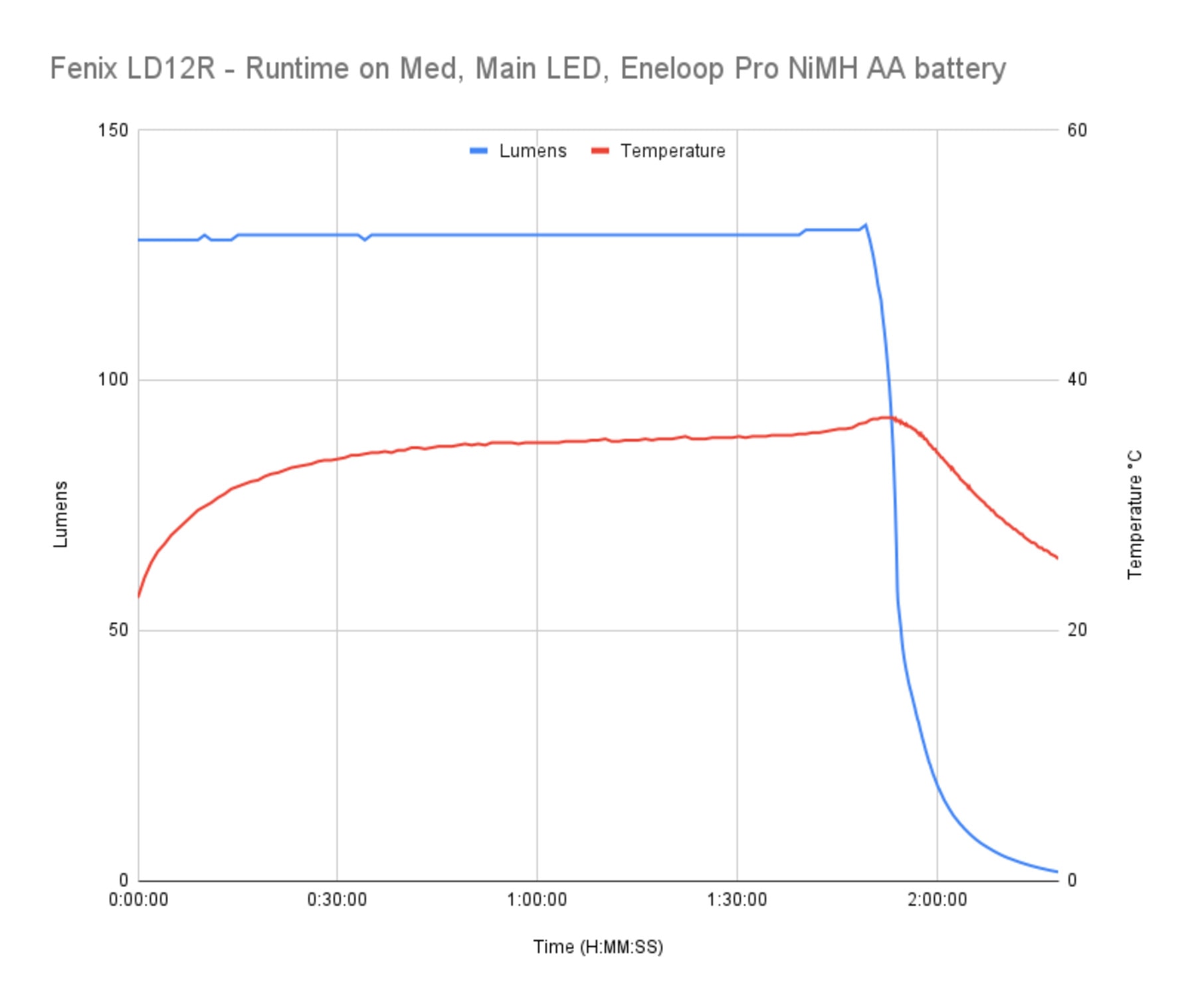
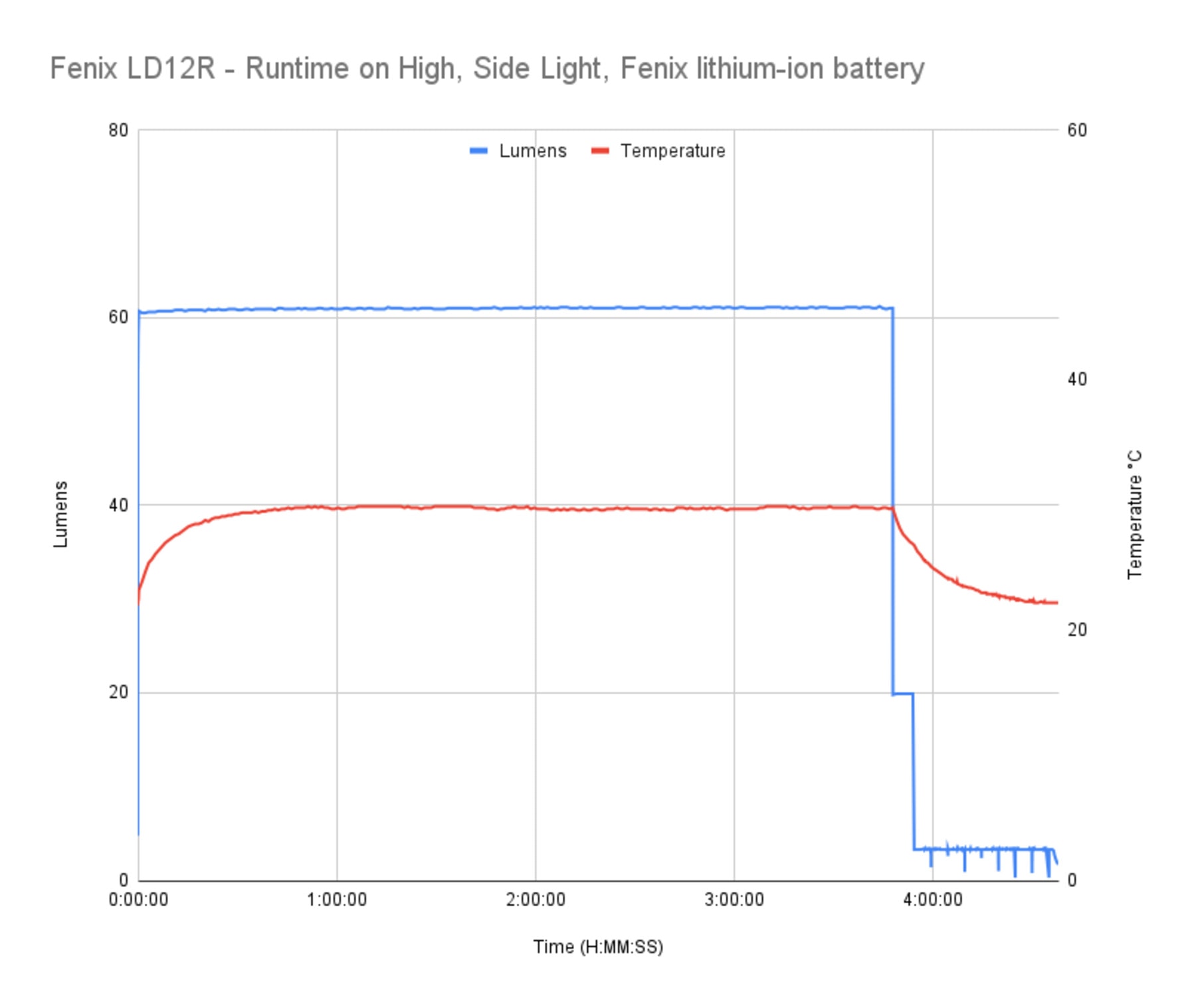
Peak beam intensity and beam distance measurements
About Peak beam intensity: Understanding ANSI FL1 Standards About peak beam intensity The calculated value of distance in meters at which the flashlight produces a light intensity of 0.25 lux. (0.25 lux is about the brightness of a full moon shining on an object). This means that the intensity has decreased so much, it becomes difficult to see darker objects, or objects that don’t reflect light. The columns ‘Meters’ and ‘Yards’ use rounded numbers.Intensity was measured at 5 meters (1 meter for the side light) after being turned on for 30 seconds. A UNI-T UT383 BT lux meter was used. The Fenix lithium-ion battery was used for testing.
| Mode | Specs | Candela measured | Meters | Yards |
|---|---|---|---|---|
| Main LED, Moon | 18 cd | – | – | – |
| Main LED, Low | 424 cd | 475 | 44 m | 48 yd |
| Main LED, Med | 2052 cd | 2275 | 95 m | 104 yd |
| Main LED, High | 8616 cd | 9525 | 195 m | 213 yd |
| Side LED, Low | 3 cd | – | – | – |
| Side LED, Med | 12 cd | 14 | 7 m | 8 yd |
| Side LED, High | 38 cd | 45 | 13 m | 15 yd |
By and large, my intensity tests match Fenix’s specs really well.
Beamshots
Camera settings and distance:
- Main LED: Beam shots of the building are taken at 30 m (33 yd) using a Pixel 7 set to ISO 800 with 1/10 second exposure time
- Side LED: Beam shots of the building are taken at 5 m (5.5 yd) using a Pixel 7 set to ISO 800 with 1/30 second exposure time
Beamshots of the following flashlights compared:
- Fenix LD12R, main LED
- Fenix LD12R, side LED
- (5m) NEXTORCH K40
- (5m) Zebralight SC53c N
- (30m) Olight Arkfeld UV
- (30m) Olight Seeker 4 Mini
Please note that beamshots are mainly intended to showcase the beam pattern and beam quality, rather than overall performance. These images are typically taken directly after activation, and do not fully represent its overall performance. For accurate performance metrics, such as output, beam distance, and runtimes, you need to look at the performance section of this review.
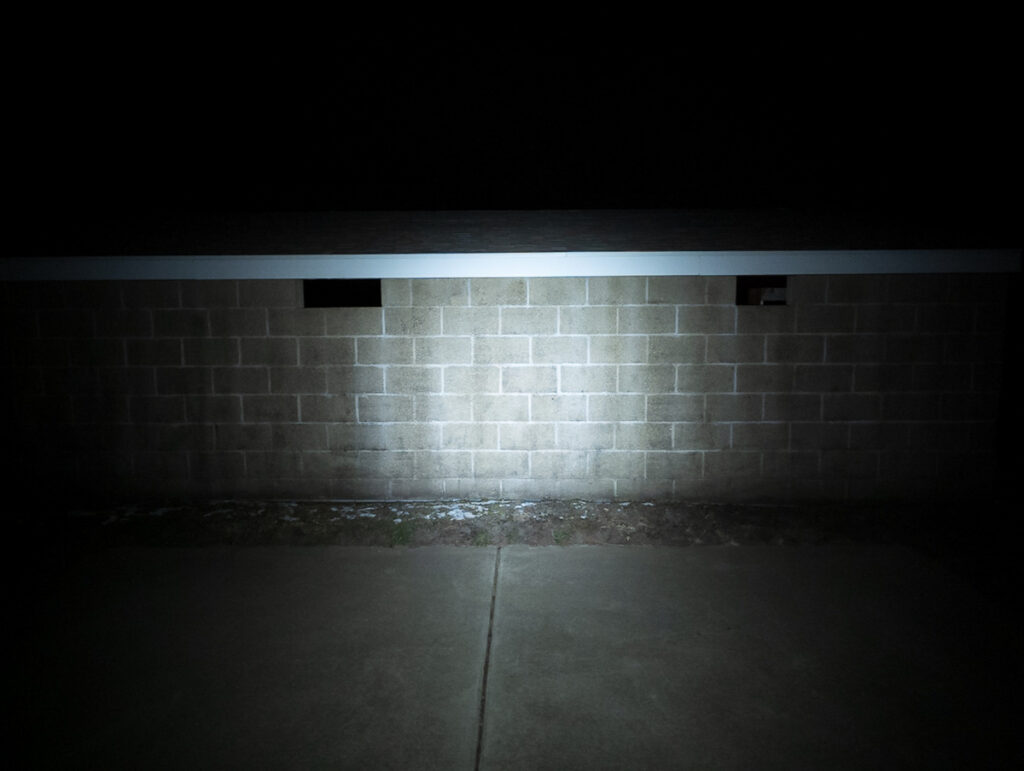
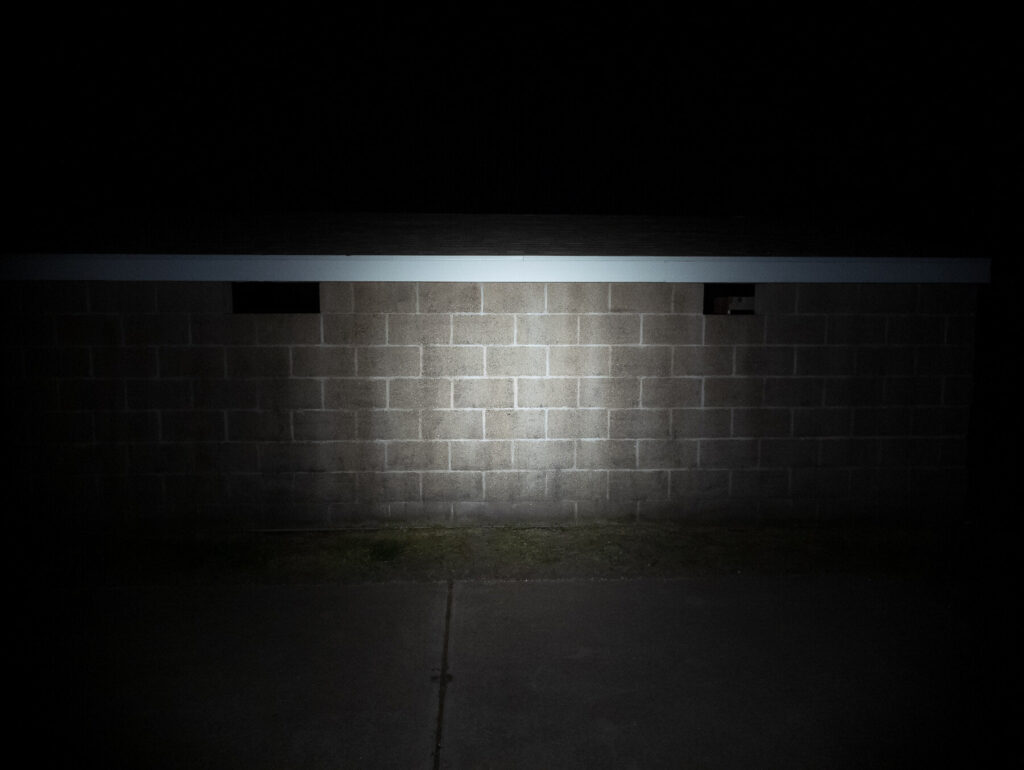
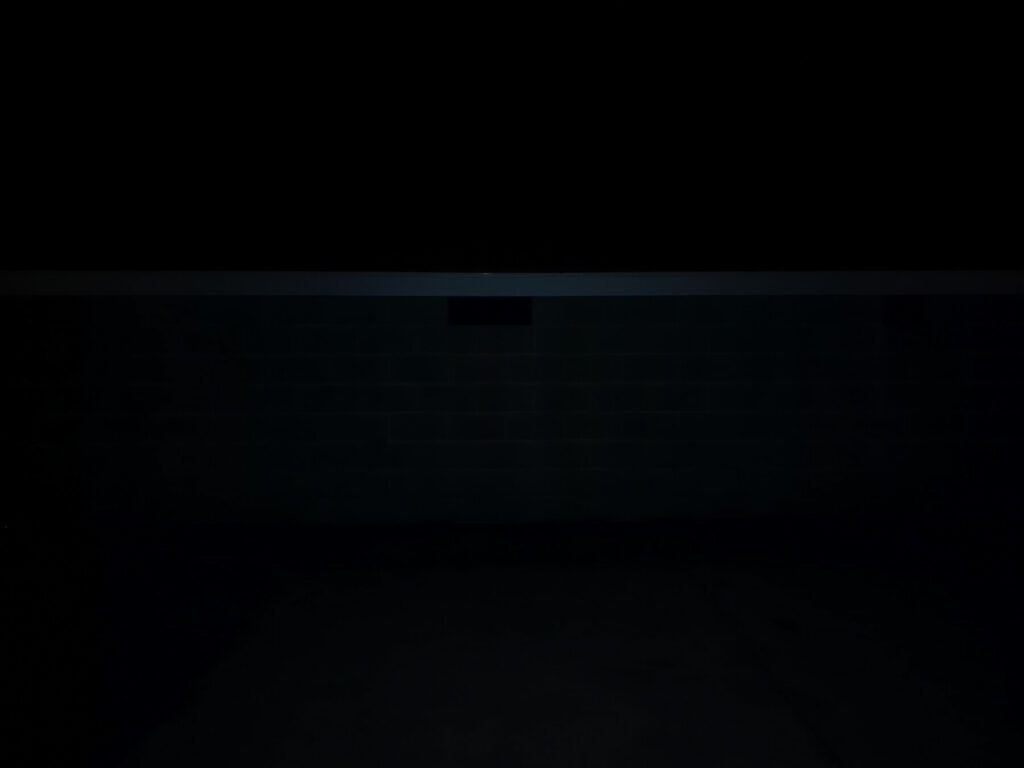
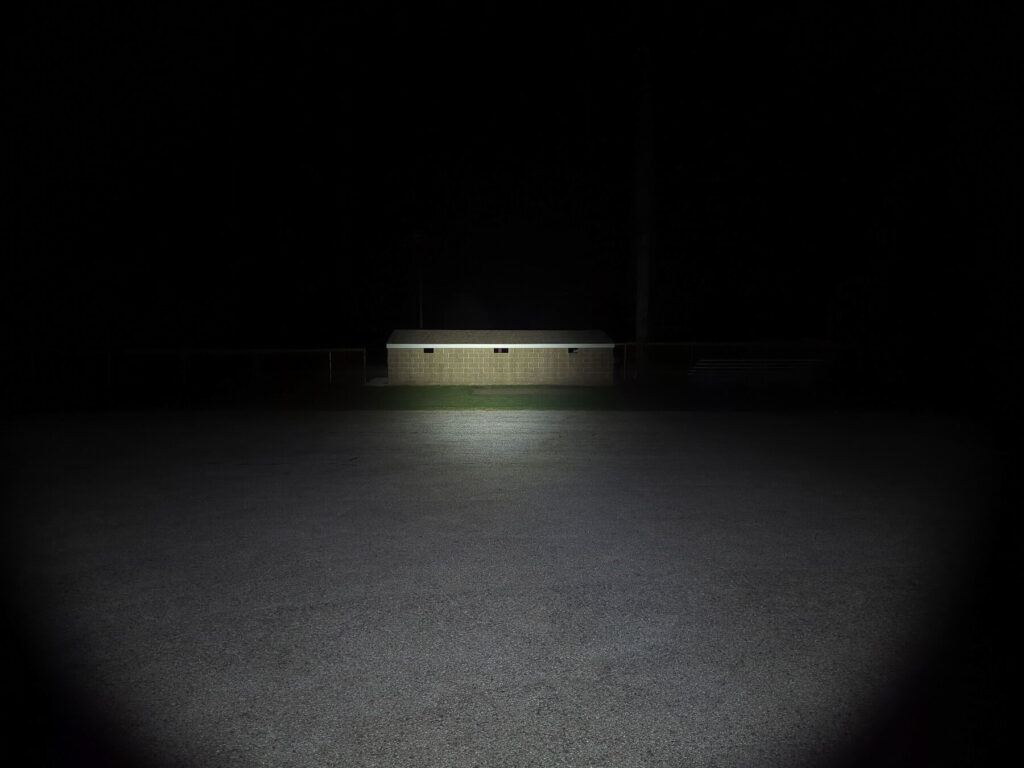
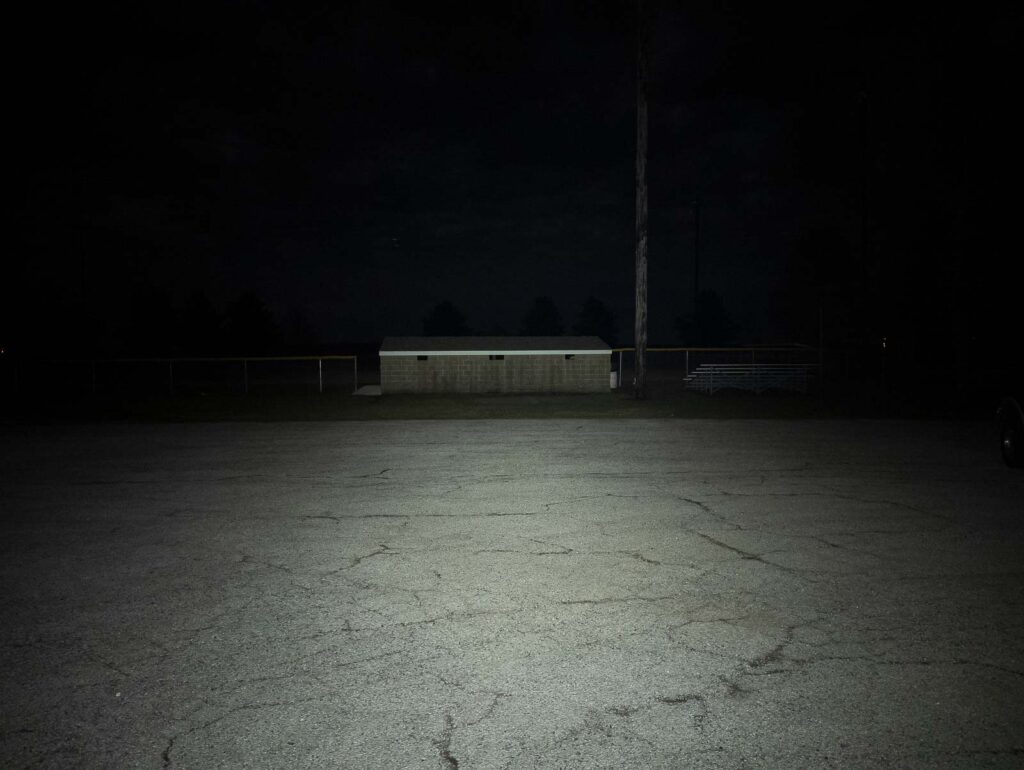

Disclaimer: This flashlight was sent to us for review at no cost by Fenix Lighting US. We have not been paid to review, nor have we been holding back on problems or defects.
Final Verdict
Pros
- Very good design and build quality
- Real simple UI
- Well regulated output
- Hidden USB-C charging
- Multi-chemistry compatibility
- Handy side light feature
- Useful magnetic pocket clip
Cons
- Cold white only
- Large for a 14500/AA light
Explanation on star ratings:
1: Avoid: a match would be a better choice – 2: Poor: significant defect or issues; almost unusable – 3: Average: some defects or issues; but still usable 4: Good: recommended (minor issues) – 5: Great: highly recommended

4 stars: ★★★★
While our star rating provides a reliable indicator, we encourage you to read the full review to make an informed decision based on your own needs and preferences.
The Fenix LD12R is an easy-to-use EDC-type flashlight from a brand that I know and trust. With its handy side light, hidden USB-C charging, and magnetic pocket clip, the LD12R is a very versatile flashlight. Is it for you? Maybe. Are you ok with cold white LEDs? And are you concerned with the size of the flashlight? If not, go for it. I usually find 14500/AA-based lights to be perfect for EDC: the 14500 is small and still packs a punch. With the LD12R, though, it’s about the same size as a lot of 18650-based flashlights. Just something to keep in mind – weigh the usefulness of the features vs the extra space required to implement them.
Buy your Fenix LD12R with a discount
Get 10% off every purchase at Fenix Lighting US, by using our exclusive 1lumen discount code: 1lumen10
1lumen selects and reviews products personally. We may earn affiliate commissions through our links, which help support our testing.